Arts and Crafts Golf Part I
by Thomas MacWood

Alister MacKenzie’s 16th at Pasatiempo
The Golden Age of golf-architecture, it is difficult to have a discussion with a serious student of golf design without it entering the conversation. The accomplished golf-architect Tom Simpson and his co-author Art historian Newton Wethered are said to have invented the term in their book The Architectural Side of Golf (1929). While it is true Wethered and Simpson did use the term ‘Golden Age’, they used it to describe a period of golf, from the haskel ball to the time of the book’s publishing. They claimed it was a great age due to the advent of modern equipment, improved maintenance practices, bright clothing, and well-furnished clubhouses, but surprisingly they never used the term in a golf-architectural context. The great Bernard Darwin did not use the term, nor did Herbert Warren Wind — actually Wind did allude to a ‘Golden Age’ in 1966, but he used it to chastise the disappointing state of contemporary golf-architecutre, writing that regrettably we were not enjoying a ‘Golden Age’ despite so many apparent advantages. It appears the first time it was used to describe a period of golf-architecture was 1976, by Donald Steel in The World Atlas of Golf, followed by Cornish and Whitten’s The Golf Course in 1981, and then Doak, Shackelford, Klein and an army of succeeding writers.
Although nearly everyone agrees on the general concept of the ‘Golden Age’ and the many talented golf-architects involved, the exact time frame varies from writer to writer — between the wars (1919-1936), turn of the century to world depression (1900-1930), the twenties (1920-1929), and the National Golf Links to Prairie Dunes (1911-1937). Perhaps a merger of these dates would make the most sense, after all many of these men, including Donald Ross and Harry Colt, created excellent work before and after these narrower periods. And to emphasize the 20’s reflects a purely American perspective, the 1930’s were productive in Europe, Japan and Canada, and the high point of British economics/golf course development occured after the turn of the century but before WWI, and it is difficult, if not impossible, to separate British development from that in America, or the rest of world for that matter.
For the sake of argument if we accept this larger time frame, and we agree that this extraordinary period began at the turn of the century, the next logical question is why it began, what were the circumstances that led to its birth. A great deal has already been written of Willie Park-Jr. launching this remarkable era at the turn of the century with his dual heathland designs of Sunningdale and Huntercombe. Sir Guy Campbell wrote that Park had laid ‘the foundation stone of golf architecture’ and ‘set the standard by which the famous architects who followed . . . developed his methods and amplified his art.’ He went on to say that Huntercombe and Sunningdale were ‘two courses of quality and continuing charm that may be said mark the springboard of modern practice.’ And we know that Herbert Fowler and Harry Colt soon followed Park, and that these three rescued golf design from the’dark ages of golf architecture’ giving rise to the so called ‘Golden Age.’ This story has been told many times — the dark ages, the heathland breakthrough, and the subsequent ‘Golden Age’ with its icons of Ross, MacKenzie, Macdonald and a number of other greats. What has not been explored, however, are the reasons why this era began. What were the circumstances that led to this dramatic change in direction that elevated golf architecture from mundane task to high art? Why are these golf courses so appealing? And what about these men who created these courses, what were their influences, what did they have in common? And finally if we are able to discover the answer to these questions, can the lesson be applied to our modern art?
The Dark Ages
It is not known exactly when golf was first played in Scotland, the earliest references date from the mid 1300’s, although some speculate a form of the game may have been played as early as 1200. We normally think of golf as an ancient game, but its popularity is relatively recent. The common image of a sport which enjoyed universal popularity throughout Scotland is not entirely accurate, its popularity was limited to specific coastal pockets. In fact in 1850 there were only 17 golf clubs in Scotland, this is when the feathery was replaced by the more practical gutta percha. The cheaper more durable gutta allowed the game to expand throughout Scotland, and to move out beyond her borders and into England. The result was an increase in the number of golf courses from 17 to 43 — still fairly modest growth. However due to the economic explosion of the late Victorian Era, fueled by the Industrial Revolution, that growth accelerated and between 1880 to1900 there were 150 new clubs established. This is the period when the modern sport of golf began.
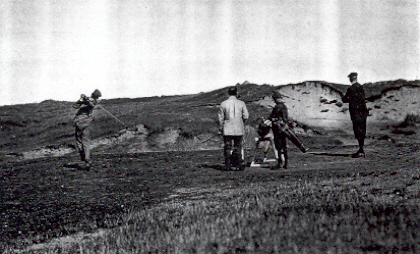
The rugged beauty of links golf.
Naturally with the game’s widespread popularity came a need to establish new golf courses and most importantly a new type of expert to lay them out. Those first golf course designers were the greenkeepers and professionals, men like Old Tom Morris, Willie Dunn and Tom Dunn. They were the native sons of the old natural golf links — St. Andrews, Musselburgh and Prestwick. But despite their familiarity with these ancient models their work was very disappointing. Tom Simpson wrote, ‘They failed to reproduce any of the features of the courses on which they were bread and born, or to realize the principles on which they had been made. Their imagination took them no further than the inception of flat gun-platform greens, invariably oblong, round or square, supported by railway embankment sides or batters . . . The bunkers that were constructed on the fairways may be described as rectangular ramparts of a peculiarly obnxious type, stretching at regular intervals across the course and having no architectural merit whatever.’
One of the reasons these men failed was due to the methods they utilized in laying out these golf courses, or the lack there of. The ancient links may have taken centuries to be formed, these men preferred a much shorter duration. There was very little time and even less forethought put into the design of a golf course. As Bernard Darwin’s described, ‘The laying out of courses used once to be a rather a rule-of-thumb business done by rather simple-minded and unimaginative people who did not go far beyond hills to drive over, hollows for putting greens and, generally speaking, holes formed on the model of a steeplechase course.’
Harry Colt recalled a particular incident, ‘A leading man on the subject was introduced for the first time to 150 acres of good golfing ground, and we all gathered around to see the golf course created instantly. It was something like following a water-deviner with his twig of hazel. Without a moments hesitation he fixed the first tee, and then, going away at full speed, he brought us up abruptly in a deep hollow, and a stake was set up to show the exact position of the first hole. Ground was selected for the second tee, and then we all started off again, and arrived in a panting state at a hollow deeper than the first, where another stake was set up for the second hole. Then away again at full speed for the third hole, and so on. Towards the end we had to tack backwards and fowards half a dozen times to get in the required number of holes. The thing was done in a few hours, lunch was eaten, and the train caught, but the course, thank heavens, was never constructed!’
Stories like that became common place as a result of the great demand to build courses near or within the large towns and cities, especially in urbanly concentrated England. In the early years the game was exclusively seaside, but the new generation of golfers were busy men unwilling or unable to waste precious time traveling. Unfortunately many of the inland sites were ill suited for the game, featuring heavy soil and poor drainage. The weaknesses of the sites were compounded by their odd Victorian design methods. C.H.Alison wrote, ‘The construction of these courses was simple in the extreme. There was only one form of bunker. This consisted of a rampart built of sods with a trench in front of it filled with a sticky substance, usually dark red in colour. The face of the rampart was perpendicular. It was precisely 3 ft. 6 ins. in height throughout, and ran at an exact right-angle to the line of play. The number of these obstacles varied according to the length . . . A stranger, therefore, was able to ascertain the bogey of hole by counting the number of bunkers, and adding two to his total . . . There were no side-hazards except long grass and trees. The fairways were invariably rectangular, and the putting-greens were square and flat . . . It will be realised that this stereotyped placing of bunkers rendered the game extremely monotonous . . . moreover, the rampart style bunker did not add to the beauty of the landscape, or lend an additional thrill to the stroke by its awe-inspiring appearance. Another notable feature . . . was the extreme flatness of the approaches. Any bold features which existed were used as hazards for the tee shot if they were used at all. Very seldom was a green placed in such a position as to render the approach play naturally interesting, while to create grass slopes or hollows artificially was an unknown art.’ New seaside construction also suffered, ‘some excellent courses already existed in 1890, but in constructing new course near the sea there was in the Victorian Era a tendency to take all hazards at a right-angle and to include a very large number of blind approaches.’
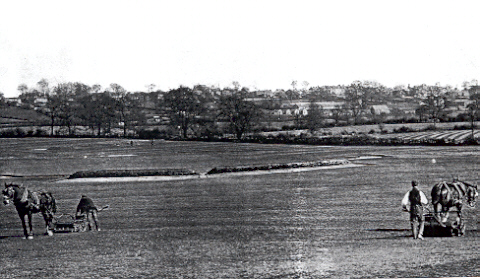
Cassiobury Park was a typical inland course.
Golf architect Alister MacKenzie added, ‘In the Victorian Era . . . almost all new golf courses were planned by professionals, and were, incidentally, amazingly bad. They were built with mathematical precision, a cop bunker extending from the rough on the one side, to the rough on the other, and similar cop bunker placed on the second shot. There was entire absence of strategy, interest and excitement except where some natural irremovable object intervened to prevent the designer from carrying out his nefarious plans.’
Of all the inland creators Tom Dunn seemed to be the busiest and most notorious. Horace Hutchinson described the scene, ‘He went about the country laying the courses out, and as he was a very courteous Nature’s gentleman, and always liked to say the pleasant thing, he gave praise to each course, as he contrived it, so liberally that some wag invented the conundrum. ‘Mention any inland course of which Tom Dunn has not said that it was the best of its kind ever seen.’ His idea—and really he had but one—was to throw up a barrier, with a ditch, called for euphony’s sake a ‘bunker,’ on the near side of it, right across the course, to be carried from the tee, another of same kind to be carried with the second shot, and similarly a third. It was a simple plan, nor is Tom Dunn to be censored because he could not evolve something more like a colourable imitation of the natural hazard. A man is not be criticized because he is not in advance of his time.’
While these new golf-course designers were successful in bringing the game to new districts and providing venues for legions of new golfers, they were utterly guilty of ignoring their native traditions — for these new golf courses were radically artificial and in direct contrast to the wonderful natural links. Instead of embracing the vernacular models of St. Andrews, North Berwick and Prestwick, these men turned their back on their traditions and on the natural. But as Hutchinson said, it was not entirely their fault, after all they were traveling unchartered territory, and when forced to cover new ground there is a tendency to fall back on current trends, and these odd designs were very much a reflection of popular aesthetic tastes.
Victorian Aesthetics
Nature designed the first golf courses. It has been repeated often, the first golfers developed the game over the barren linksland. The first golf courses were discovered not built and evolved slowly and naturally. So when the game’s popularity took off in the second half the 19th century and there became a demand for new courses in new locals, it no doubt presented a dilemma. The old links had not been’designed’ by man and there was very little precedent for the design process. Certainly there had been limited intervention by early golfers on these natural links, but now these golf professionals were asked to devise completely new golf courses. Although most of these men were ill educated, they were still products of a modern nation — a nation blessed with superior know-how, artistic sophistication and technological advantage — so when presented with the challenge of ‘design’, these first golf designers naturally turned to the cultural influences and contemporary aesthetic tastes for their creative model.
To fully understand contemporary Victorian tastes, you must look to the preceding period. Pre-Victorian Britain benefited from the defeat of France at Waterloo and an economic boom as a result of the early industrial revolution. The culture of this period was dominated by the aristocratic class. Britain was ruled by an opulent landed aristocracy, whose life style was highly enviable. This lifestyle was epitomized by the large country houses, supported by great estates and filled with collections of antiques, sculptures, books and fine pictures by old masters. The acknowledged measure of taste for the aristocracy, at least for those formally educated, was provided by the art and literature of ancient Greece and Rome (whose prestige had been amplified by the Renaissance), a result of an emphasis of Greek and Latin in the curricula of schools and universities all over Europe. Classicism was the pattern of taste to be found in all the major European states of the 18th century and dominated imperial Britain. The return to the principles of Classic art and architecture was a return to strictly defined aesthetic order, as well, evoking the glories of Ancient Rome. The result was architecture based on rules, order and clarity, where straight lines were favored over curves, of strict proportions and defined volumes, and above all brutal symmetry.
Ironically as architecture was emphasizing rigid structure and order, garden art was rejecting the formal for the natural. In the eighteenth century men like William Kent, Capability Brown and Humphry Repton began creating idealized visions of the natural landscape as opposed to the geometric formality of their predecessors. This phase was known as the Picturesque and it was inspired by the carefully contrived landscape paintings of the 17th century and a renewed interest in the medieval past. At the dawn of the Victorian era (1837 -1901) these two styles, the Picturesque and Classical, existed amicably side by side.
Entering the early Victorian era (1830 -1850) the Classical tradition in architecture continued to dominate, Classical being the natural choice for most public buildings throughout the period. During the High Victorian period (1850 -1870), although neoclassical buildings continued to be built, it was the Renaissance revival which was predominant. The new richness of this mode was largely French inspired and featured opulent decoration. This was also when a Gothic revival began to gather pace, sparked by the House of Parliament by Sir Charles Barry, the result of a design competition in which ‘Gothic’ or ‘Elizabethan’ styles was stipulated. But even the normally organic Gothic was presented by Barry in a Classical form in the general symmetrical arrangement of the building.
As the Picturesque garden style was becoming fashionable throughout Europe, ironically Victorian designers were rediscovering the geometric gardens of the Italian Renaissance. The naturally inspired garden had enjoyed its day, and from around 1830 the formal garden was back in favor. Not unlike the over stylized Victorian interiors, the gardens of this period were stuffed with ideas — geometric topiary, color, structures, themes and exotic plants. Even the conventional arts were not immune from this insistence on formality and strict order. The Royal Academy, which dominated all aspects of artistic thought, taught art students to compose paintings with pyramidal groupings of figures, one major source of light at one side matched by a lesser on the opposite, and an emphasis on rich tone at the expense of color.
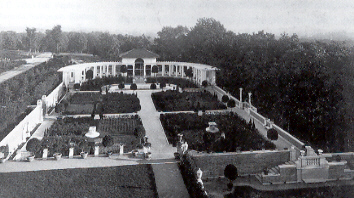
Victorian symmetry and formality.
It was under this backdrop that the early golf designers began, but Victorian aesthetic tastes were not the lone factor effecting those first golf-architects. A number of other sports were gaining converts among the middle class — cricket and tennis in particular were enjoying similar popularity. Like golf these sports featured a weapon as well as a ball, and like golf these games were played on grass, however cricket and tennis were played over a level lawn of strict geometric dimensions. So when golf was brought inland to the urban centers, it seems reasonable to believe that many of the turf specialists involved in constructing these playing lawns, would have also been involved in some capacity with these early golf fields. And beyond these aesthetic influences, there were also cost factors, golf required a fairly large parcel of land which was comparatively expensive. These first designers were keenly aware of the finacial pressures of their sport, and believed quick, simple and cheaply constructed courses was the only way to proceed. Considering the entire cultural climate, it is not difficult to comprehend why the Victorian golf-architects produced such unnatural work.
Part II
The Reformers
From the aesthetics of Victorian England came three influential dissenters — Pugin, Ruskin and Morris — with Augustus Welby Northmore Pugin (1812 -1852) being the first. His father, A.C. Pugin, had come to England during the French Revolution and worked for the architect John Nash, drawing the fashionable Gothic details that his clients demanded and Nash detested. AWN Pugin, born in London in 1812, assisted his father as a boy with both his designs and in the production of several books on Gothic architecture. In fact the younger Pugin was thought to be even more knowledgeable than his father and at 15, was chosen to design the faux-Gothic furniture for Windsor Castle. (He later called these designs ‘enormities’ and remarked that ‘a man who remains any length of time in a modern Gothic room, and escapes without being wounded by some minutiae, may consider himself extremely fortunate’)
As a youth Pugin was intensely fond of the sea (He once said, ‘There is nothing worth living for but Christian architecture and a boat’) and ironically his life would be rocked by constant turbulence. He found himself shipwrecked off the Firth of Forth in 1830, got married in 1831, lost his wife a year later, got married again in 1833, lost his second wife in 1844, got married once more in 1848, and lost his mind in 1851. A short life that included three marriages, eight children and over a hundred designs (mostly churches) and great quantities of ornaments, furniture and vestments. He drew every line himself and when asked why he didn’t give the mechanical part of the work to a clerk, he replied, ‘Clerk, my dear sir, clerk, I never employ one: I should kill him in a week.’ Pugin died at the age of forty from overwork.
The turning point in Pugin’s life was his conversion to Catholicism in 1835. The following year he published a book entitled Contrasts (a slight reduction from its original title, A Parallel between the Noble Edifices of the Fourteenth and Fifteenth Centuries, and Similar Buildings of the Present Day; Shewing the Present Decay of Taste). In the book Pugin argued that Gothic was the only true Christian architecture. It was illustrated by brilliant comparisons between the ‘meanness, cruelty and vulgarity’ of buildings of his own day, the Classical and faux-Gothic, and the glories of the true Gothic of the pre-Reformation Catholic past. He claimed Gothic architecture was produced by the Catholic faith and that Classic architecture was Pagan. The Reformation had been a dreadful scourge, and medieval architecture was greatly superior to anything produced by the Renaissance or Classic revivals — ‘a bastard Greek, nondescript modern style has ravaged many of the most interesting cities of Europe.’
Pugin believed that beauty should grow from necessity, that there were two great rules for design, ‘1st, that there should be no features about a building, which are not necessary for convenience, construction or propriety; 2nd, that all ornament should consist of the essential construction of the building.’ These two principles would influence the succeeding Arts and Crafts Movement, and eventually led to freely composed asymmetrical buildings. ‘Architectural features are continually tacked on buildings which they have no connection, merely for the sake of what is termed effect; and ornaments are actually constructed, instead of forming the decoration of construction, to which in good taste they should always be subservient.’
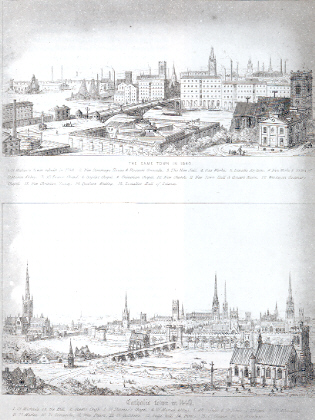
AWN Pugin, ‘Contrasts’, showing the same town in Victorian and middles ages.
Another of his doctrines was ‘fidelity to place’, and it too was adopted by the Arts and Crafts movement. It argued that environmental factors were responsible for a given areas architectural traditions and styles. To create a truly sympathetic design one must embrace those naturally evolved regional traditions along with the materials naturally found in the area. For example, Pugin’s design at St.Augustines reflected the regional Gothic tradition and was constructed of local Kentish brown stones excavated nearby. ‘What does an Italian house do in England?’, railing against the prevailing fashion for Italianate villas.’Is there a similarity between our climate and that of Italy? Not in the least . . . another objection to Italian architecture is this — we are not Italians, we are Englishmen.’
John Ruskin (1819 -1900) was the first professor of art history at Oxford University and the most influential art critic of his day. He shared Pugin’s disgust with the classical world, not because it was ‘pagan’ but because its aesthetic was based on symmetry and regulation. For Ruskin the opposite qualities — asymmetry, irregularity and roughness — made Gothic architecture superior. One of the sternest critics of industrialization and the only Arts and Crafts reformer to reject the use of machinery altogether, Ruskin believed the industrial revolution had turned designers into anonymous laborers. Only by returning to handwork would individuality be restored and along with it, quality.
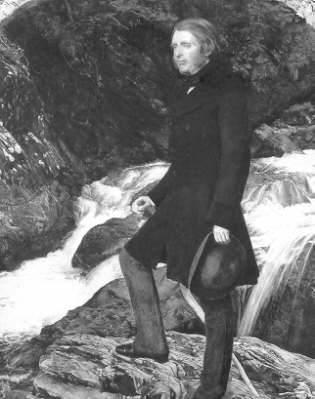
‘John Ruskin’ by JE Millais, Pre-Raphaelite artist.
The son of a wealthy and cultivated London sherry merchant, Ruskin’s upbringing was abnormally strict, however he was always encouraged to read, write, and draw, and to appreciate the beauties of nature. Following an education at Oxford, he became well-known as a critic of landscape painting and champion of the works of the painter Turner and the Pre-Raphaelites, a group of artists who were opposed to the stale formula-driven art produced by the Royal Academy. Ruskin promoted contemporary art and artists, which accelerated collection of these works by the new middle class. At the same time he was rejecting classicality, ‘All classicality . . . is utterly vain and absurd, if we are to do anything great, good, awful, religious, it must be got out of our own little island, and out of these very times, railroads and all.’ Like Pugin before him Ruskin argued that Gothic was the architecture of northern Europe and that unlike Classical architecture built by slaves, it was the product of free craftsmen. Classical’s aim was perfection of execution according to a series of clearly defined rules, ‘in the end any workman could produce it if he were beaten hard enough.’
Ruskin maintained that architecture should be true, with no hidden structures, no veneers or finishes and beauty in architecture was only possible if inspired by nature. Truly humane architecture must be imperfect — what he called savage, the Gothic ‘naturalism’. The Gothic craftsman, Ruskin believed, not only expressed his own imperfections in his art, but by studying nature, the imperfections of his subjects as well. Because Gothic was not tied to strict rules, it was ‘the only rational architecture,’ for it could fit itself to every use or circumstance. ‘It is one of the chief virtues of the Gothic builders, that they never suffered ideas of outside symmetries and consistencies to interfere with the real use and value of what they did . . . If they wanted a window, they opened one; a room, they added one; a buttress, they built one; utterly regardless of any established conventionalities of external appearance, knowing . . . that such daring interruptions of the formal plan would rather give additional interest to its symmetry than injure it.’
Ruskin’s two most famous books, The Seven Lamps of Architecture and The Stones of Venice, established criteria for judging art that were followed well into the twentieth century. The Seven Lamps of Architecture was a personal reaction against the rigidity of the classical style. Ruskin concerns himself with defining the ethical and spiritual, as well as the aesthetic nature of architecture.
The Lamp of Sacrifice – Architecture by definition is an art which rises above’building’ and requires additional effort and resources which are not necessary to strict utility
The Lamp of Truth – No disguised supports, no sham materials, no machine work for handwork
The Lamp of Power – Refers to the effect of architecture to consciously inspire awe
The Lamp of Beauty – Only possible through imitation of, or inspiration from nature
The Lamp of Life – Architecture must express a fullness of life; embrace boldness and irregularity, scorn refinement and also be the work of men as men
The Lamp of Memory – The greatest glory of a building is its age and we must therefore build for permanence
The Lamp of Obedience – Architecture should be conservative. Expression is good, but preoccupation with originality is essentially bad. Architects should not seek to consciously introduce new Style
In his later years Ruskin was devoted to social and political issues, advocating a form of state socialism. One of his last political efforts was the founding the St.George’s Guild, a society to pursue the ideals of the dignity of labor and fight against machines and its alienating effect. The experiment failed, while embracing what he called socialism, Ruskin always stressed ‘the impossibility of equality.’ In 1880 he began to suffer a progressive mental collapse, and was unable to testify during the Whistler trial when the artist sued Ruskin for libel. The last years of his life were a gradual descent into madness.
While Ruskin was one of the most widely read English authors, William Morris’ (1834-1896) influence was even more far reaching. He too was a prolific lecturer and writer whose works were popular on both sides of the Atlantic, but his stature as the versatile figure of the Arts and Crafts movement came from the example he set as a consummate craftsman.
Morris was born in Walthamstow, the son of a successful businessman. In 1840, when Morris was six, his father acquired a fortune speculating in Devon copper mine, and the family moved to Woodford Hall on the edge of Epping Forest. The Epping period — spent riding horses, fishing, hunting, gardening, bread baking, brewing beer, learning of plants and birds — formed Morris’s enduring appreciation of nature. When his father died in 1847, the family was forced to move back to Walthamstow. All his life, Morris tried to recreate the idyllic, almost medieval life at Woodford Hall.

Edward Burne-Jones and William Morris.
A love for medieval beauty was fostered during his undergraduate years at Oxford, little changed since the fifteenth century. Having gone there to study for the ministry, he read The Stones of Venice and decided to become an architect. After experimenting with both architecture and painting, Morris devoted himself to the decorative arts. In 1861 he formed what would become Morris and Company, a collaborative effort with a goal of uniting all the arts. The Pre-Raphaelite painters Dante Gabriel Rossetti, Edward Burne-Jones and Edward Madox Brown, and the architect Phillip Webb were also founding members. Their diverse talents combined to produce furniture, stained glass, wall-paintings, decorative tiles, embroidery, wallpaper, tapestry and metalwork. Morris was the embodiment of the Arts and Craft movement; blending art, ideals and business.
Morris’s design patterns for wall paper, textiles and tapestries (which remain popular to this day), were derived from the underlying geometry of flowers and plants, and was characterized by natural materials. As a Ruskin disciple, Morris understood the importance of craft work as well as design. ‘For . . . everything made by man’s hand has a form, which must be either beautiful or ugly; beautiful if it is in accord with nature, and helps her; ugly if it is discordant with nature, and thwarts her.’
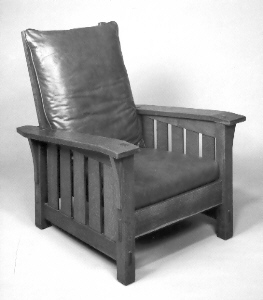
Morris chair, Stickley’s Craftsman Workshops (1910).
Morris believed that if the new architecture and planning were to draw inspiration from the old, preservation of historic work was vitally important — not only as a model, but as reminder of the continuity of past, present and future. He formed the Society for the Protection of Ancient Buildings (SPAB) in 1877. Morris had been outraged by a proposal by the architect Sir Gilbert Scott to restore Tewksbury Abbey.’My eyes just caught the word ‘restoration’ in the morning paper, and on looking closer, I saw that this time it is nothing less than the Minster of Tewksbury that is to be destroyed by Sir Gilbert Scott.’ So begins a letter which Morris sent to the newspaper Athenaeum as a protest against the wide spread practice of church restoration.
Earlier restorations by Victorian architects intended to modernize or return buildings to their original state had, in Morris’s view, ruined much fine medieval architecture, partly through ignorance and partly through the use of modern construction methods, under which it was impossible for carvers to express the true Gothic savageness. Morris also alleged that architects advised large-scale rebuilding to increase their commissions, which was later supported by a document that showed spending on church restoration had outstripped new construction for the previous twenty years. SPAB successfully popularized a doctrine of ‘honest’ repair rather than wholesale restoration to a state of perfection which often had reality not in history but the architects imagination. In the SPAB manifesto Morris urged, ‘to treat our ancient buildings as monuments of a bygone art, created by bygone manners, that modern art cannot meddle with without destroying, Thus, and thus only . . . Can we protect out ancient buildings and hand them down instructive and venerable to those that come after us.’ The obvious result of SPAB was preservation, but it also enabled Morris to extol the simplicity and beauty of vernacular buildings, which became the inspiration for the Arts and Crafts architects that followed.
In 1883 Morris became a member of the Democratic Federation, the only socialist body then in existence. It was the start of commitment to the socialist movement for which he remained faithful to the end of his life. A successful capitalist who preached communism; a designer of mass-produced art who believed in the freedom of individual craftsman; a beneficiary of machine-made ornament who preferred utter simplicity — the Morris paradox.
The Arts and Crafts Movement
The Arts and Crafts movement has long confounded historians. Although it is universally agreed to have started in Britain, there is little agreement as to exactly when it began — or exactly when it ended for that matter. Its evolution was a gradual process rather than a sudden revelation. To further complicate matters it was an artistic movement without a definitive style. The movement promoted individualism and the incorporation of regional traditions, resulting in startling diversity from an ‘Olde English’ cottage in Cotswold to an Adobe inspired home in Santa Fe. As A&C historian Eizabeth Cumming wrote, ‘Although practitioners had widely differing agendas, they shared the ideal of individual expression, of design that could draw inspiration from the past but would be no slavish imitation of historical models. Buildings were crafted of local materials and designed to fit into the landscape and reflect vernacular tradition.’
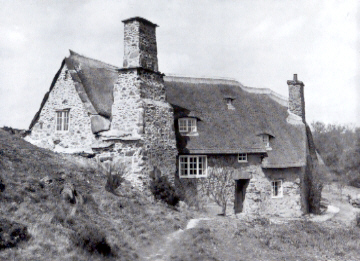
Ernest Gimson, Stoneywell Cottage, Leicester, Devon (1898)
And because it was not so much a style as an approach, the Arts and Crafts movement has been little more than a foot note historically. Its recognition can be traced to Modern architecture’s inability to find humanity and individualism, allowing the simplicity, informality and honesty of the Arts and Crafts movement to enjoy a resurgence. And with this renewed interest, architectural and social historians have begun to recognize ‘the immense scale and range of both professional and amateur Arts and Crafts activity and to unravel its complex and sometimes contradictory ideologies’.
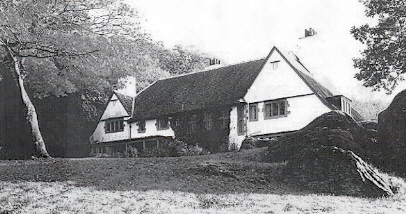
CFA Voysey, Moorcrag, Lake Windemere, Cumbria (1899).
The roots of the Arts and Crafts movement can be traced to 1851 and the Great Exhibition in London. Held in the eighteen-acre Crystal Palace, the event was a celebration of British wealth, power and know-how, designed to showcase the artistic prowess of a great industrial nation. Queen Victoria who opened the Great Exhibition declared ‘our People have shown such taste in the their manufacturing.’ More discriminating visitors disagreed, seeing the cheap, mass-produced household goods and shoddy ‘art-objects’ as a dreadful indictment on the sad state of British design. Artist Edward Burne-Jones, spoke of the ‘gigantic weariness’ of the exhibition, Pugin described the Crystal Palace as a ‘glass monster’ and Morris dismissed the exhibits as ‘wonderfully ugly.’ For these men the Great Exhibition illustrated there was a clear need for reform.
Britain was the first country to industrialize. Britain was also the first to react against the consequences of industrialization. The Arts and Crafts movement began as a reaction to the squalor, ugliness and inequalities caused by the Industrial revolution — the dehumanization of the worker and the evils of the machine. It was reforming movement in architecture and design that evolved from the writings of Pugin, Ruskin and Morris — but at its core was an over riding concern with quality of life.
The Arts and Crafts movement rejected ‘style’ as an artificial imposition, its designs were distinguished by an ‘insistence on modesty and simplicity . . . And on the inherent qualities of natural material simply worked.’ The architect Phillip Webb, who designed William Morris’s home Red House, exemplified this new point of view. For Webb the land ‘was not merely ‘nature’ . . . and art was not taste but the human spirit made visible.’ He believed that the root of architecture was the land. Before designing a new building, he walked over the site until it ‘relinquished its full possibilities,’ and offered up ‘particular suggestions.’ That ability to weave nature and architecture together revived the quest for an organic architecture. The Arts and Crafts architects successfully ‘recreated the past as a world of pre-industrial simplicity, ‘quaint’ and ‘old fashioned’, whose point of reference was the small manor house, farmhouse or cottage. Houses were no longer built to look new, but old, being irregular, distinct and tucked away into the folds of the landscape which they no longer sought to dominate.’
The movement became aware of itself in 1880’s when it first gave itself a name and it was in that decade that it emerged with recognizable message, it began to flourish in the 1890’s and it achieved its most brilliant effect in the decades around the turn of the century. The term Arts and Crafts, in its own era, signified a general association of like-minded artists, designers, manufacturers and crafts people. And although they were highly individualistic and could not be pinned to a definable style, they shared many ideals: honest construction and simplicity of form, fitness for purpose, harmony between the man-made and environment, the revival of traditional craft techniques and the inherent qualities of natural materials. If forced to pinpoint the four universal principals they would be — design unity, joy of labor, individualism and regionalism — these combined to create the Arts and Crafts approach.
What began as an English movement, eventually found its way to the Continent and America. In Northern Europe designers were inspired but didn’t necessarily follow its model. Only in America was it directly copied, adapted and developed on a parallel tract. The American movement’s zenith lagged a decade, or so, behind the British movement, but both flourished in an age of prosperity, ironically created by industrial achievement. Likewise the movement’s decline can be traced to economic weakness — the Great War in Britain and the Depression in America.
Another difficulty in defining the A&C movement was its universal influence on all artistic expression and design. It not only touched architecture, the Arts and Craft house being the supreme embodiment of the movement, but also garden design, furniture, fine arts, glassware, metalwork, ceramics and textiles. Among its many extraordinary disciples were the architects – Phillip Webb, WR Lethaby, CFA Voysey, Edwin Lutyens, Charles Rennie Mackintosh, Charles Ashbee, HH Richardson, Stanford White, Bernard Maybeck, Frank Lloyd Wright and the Greene brothers; garden designers – William Robinson and Gertrude Jekyll; furniture makers – Gustav Stickley and George Niedecken; glass and metalwork – Louis Comfort Tiffany and DirkVan Erp; and ceramics – William Grueby. From jewelry and candlesticks to tea-kettles and clocks, no object of design was untouched by the eloquence of the Arts and Crafts argument, including golf-architecture.
Part III
Country Life
One day in 1896, Edward Hudson owner of a successful family firm of printers, Hudson & Kearns, was playing golf at Woking with one of his business partners, George Riddell, a solicitor with financial holdings in the magazine publishing business George Newnes Ltd. After the round they talked about Hudson’s latest venture, the weekly Racing Illustrated, which looked good but unfortunately was floundering financially. It was then that the idea of relaunching it as a magazine of general interest for lovers of the countryside. And so on January 8, 1897, there appeared the first issue of Country Life.
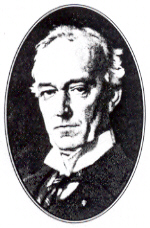

George Riddell & Edward Hudson
Hudson and Riddell typified the energetic and enterprising set of Victorian London, they were urban commercial animals out to make their fortune. George Allardice Riddell (1865-1934) was enjoying a meteoric career, the son of a Brixton photographer, he was able to push his way up through the legal profession from nothing, making his fortune first as legal adviser and then chairman of the Sunday sensation, The News of the World. Although his reputation was far from savory, he was an influential force within British politics and eventually became Lord Riddell of Walton Heath. He was head of the Newnes publishing company when Country Life was unleashed, and he was also passionate about golf.
But of the two it was Edward Hudson (1854-1936) who would become the dominant force, guiding the magazine for its first thirty-five years. He clearly had a touch of genius about him, despite an awkward nature. ‘Ill educated and apparently inarticulate to a degree that surprised those who knew his gifts as connoisseur and entrepreneur’, he nevertheless exercised an eye for quality. In the same way he collected furniture and art, he collected talented people. From the beginning the emphasis was on quality — in photography, writing, printing and block-making — Hudson took a paternal interest in every aspect of his magazine, according to veteran contributor Bernard Darwin, ‘ his love for it was so palpably moving that to show, even for a moment, a lack of interest in anything to do with Country Life would have been an impossible brutality.’
Country Life billed itself as ‘the journal for all interested in country life and country pursuits’ at a time when eighty percent of the population was urban based, this focus on the country was well timed. Housing within inner London, and the other industrialized cities, was quite bleak and the view of the tranquil countryside, offered by prominent writers and thinkers such as John Ruskin, was a positive alternative. That view followed a long literary tradition, one with which every public-school educated reader of Country Life would have been familiar. That age old image of landed gentry — country gentleman, ancient manor houses and their gardens, tranquil views of an unspoiled landscape — was a powerful one. But by 1897 the aristocracy and gentry were a defeated class, the Third Reform Act had given the vote to the non-propertied working classes, the agricultural depression of the late 1870’s had severely eroded the profits of their great estates and the Death Duties of 1894 had negatively impacted the ease of inherited privilege, the landscape was changing both figuratively and literally. The new rich from the commercial and professional classes could now aspire to that romantic aristocratic lifestyle and Country Life took full advantage of the circumstances, the magazine‘was directed at readers who might well be members of a Surrey golf club. The electric underground and more reliable motor cars provided opportunities for the prosperous to build houses in the still unspoiled rural landscape and enjoy the conventional pleasures of country life, gardening, riding and golf.’
From its first issue, Country Life‘s formula was apparent. A full-page portrait of Lord Suffolk occupies one page. There are illustrated historical account of a country house, sports reports, and a golfing feature. Most prominent were ten full pages of equestrian news, mainly racing and bloodstock gossip. This soon gave way to regular reports and features on other sports, including polo, hockey, cricket, rowing, yachting, rugby, soccer, and cycling. ‘The magazine would carry articles on country houses and gardens, antiques, natural history, traditional country pursuits (most of which seemed to involve killing something) and sporting occasions frequented by high society.’
In the early years the magazine’s impact was primarily visual rather than literary, it was ‘looked at more than read, a consequence of the expertise of the magazines photographers.’ As Bernard Darwin wrote in Fifty Years of Country Life, the magazine was designed to be ‘a weekly illustrated paper of the highest quality that should get the possible results from the half-tone blocks.’ Exacting about quality ‘expense was an entirely secondary consideration,’ Hudson was fortunate in securing the services of two great photographers who established the magazine’s style — Charles Latham and Frederick Evans. Their brilliant images compensated for any initial shortcomings in writing and created Country Life’s reputation for superb photography. Photos that show a remarkable sensitivity to atmosphere and space. Enhanced by the even light and crystal sharp detail achieved by a long exposure, inspired by the English landscape artist Turner.
Soon the quality of writing would match the imagery. The early ‘flowery evocations had been supplanted by historical scholarship based on original research in the case of old houses and by professional architectural criticism in the case of the new. The lead was now taken by the writers rather than the photographers.’ And Hudson had a extraordinary ability to attract contributors whose influence lasted well beyond their own active involvement in the magazine. One of the earliest and most famous contributors was Gertrude Jekyll (1843-1932) whom met Hudson in 1899 and was already a well established figure in the gardening world. Jekyll, an apostle of the Arts and Crafts movement, edited ‘Garden Notes’ for Country Life for thirty years, becoming a landmark figure in the history of twentieth-century gardening with designs that integrated house and garden, architecture with nature. Blessed with painter’s eye, she lifted gardening to the status of fine art — not a surprising result considering her relationship with Ruskin, Morris and many of the well-known artists of the period. She personified the A&C ideal of unity in the arts. Through Jekyll, Hudson met the young architect Edwin Lutyens (1869-1944), who immediately commissioned to build Deanery Garden, his first country house in Berkshire. Jekyll laid out the garden, achieving a perfect marriage of architecture and nature. Icons of an English way of life, Lutyens and Jekyll would team for nearly two decades, creating a new standard of excellence epitomized by the phrase ‘a Lutyens house and Jekyll garden.’ Hudson would again call on Lutyens on three more commissions: Lindisfarne Castle (1902), the Country Life Building (1904) and Plumton Place (1928) in Sussex. The Country Life connection was a tremendous benefit to Lutyens, and resulted in several golf related clients including Alfred Lyttelton’s Greywalls on the Muirfield links and George Sitwell’s club-house at Dr.MacKenzie’s notorious Sitwell Park — ironically Lutyens didn’t play the game. The seductive images presented by Country Life of Lutyens and Jekyll’s work not only ignited their careers, but also fueled appreciation for Arts and Crafts aesthetics in general.
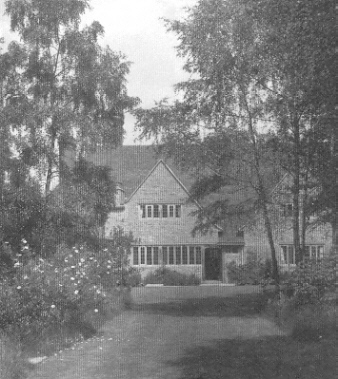
Jekyll’s home–Edwin Lutyens, Munstead Wood, Godalming, Surrey (1896).
There were many other important figures in the early years of the magazine, including H. Avery Tipping (1855-1933) an authority on English interiors, furniture and architecture. He was ‘the first to apply methods of historical research to the subject’ and his articles were genuine contributions to architectural history. His influence brought the country house and garden center stage with the magazine. CL Cornish wrote on natural history. L.March Phillips was a prominent art historian and writer of color theory. Lawrence Weaver (1876- 1930) was another architectural writer. Although Hudson was an great advocate of Lutyens work, the magazine showed little commitment to contemporary architecture. Under Weaver’s guidance, Country Life championed the architects of the Arts and Crafts movement, and sponsored architectural competitions featuring informed architectural critique. He, more than anyone earned the magazine’s title, as ‘the keeper of the architectural conscience of the nation.’ Percy Macquoid was the contributor in the antiques field, he would go on to write the landmark study The History of English Furniture. Editor from 1900 to 1925, Peter Anderson Graham wrote numerous columns, including ‘Country Notes’, ‘Agricultural Notes’ and ‘The Book of the Week’, he was described as ‘a leisurely man of letters rather than a working journalist . . . a dignified unpretentious figure in baggy country clothes.’ And of course the golfing correspondent was Bernard Darwin (1876-1961), the grandson of the naturalist Charles Darwin. Darwin was simply the greatest golf writer the game has ever produced. For nearly fifty years, beginning in 1908, he contributed to the weekly golf column ‘On the Green’, and he also authored the history of the magazine on the occasion of its fiftieth birthday in 1947. Like his architectural colleagues, he too organized a ‘golfing architectural competition’ in conjunction with C.B. Macdonald (judged by Darwin, Horace Hutchinson and Herbert Fowler), with Dr.MacKenzie taking home the first place prize for ‘the best original two-shot hole.’
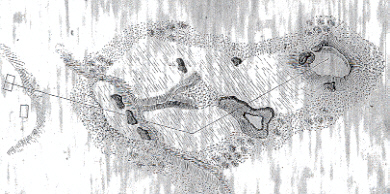
Tom Simpson’s entry after the fact.
In a few short years not only was Country Life financially successful, but it was successful in depicting a vision of rural life that had enormous popular appeal. ‘Country Life represented a potent image of national identify, embodied in the beauties of the countryside and the past.’ Thanks to the quality of its printing and production, the quality of advertising in attracted and the ability of its writers and photographers Country Life was successful in creating a vision of England that William Morris and the proponents of the Arts and Crafts movement had sought — ironic, considering this vision of a rural utopia was targeted at the privileged. But despite this paradox, the Country Life era was a marvelously optimistic one in which ‘all the arts seemed to moving to a minor Renaissance creating in the process a distinct English style.’
The Guide
Bernard Darwin wasn’t Country Life’s first golf editor, that distinction goes to Horace Hutchinson (1859-1932). The very first issue of January 8, 1897 featured a serialized version of After Dinner Golf, a book written by Hutchinson the previous year. For the next two decades, Huthinson was contributing editor of the weekly golf column ‘On the Green’ — and he was an intelligent choice for not only was he England’s foremost expert on the game but he was also something of a Renaissance Man, well versed in natural history, literature, as well as fishing and shooting, and he contributed pieces on all these subjects. As Darwin wrote, ‘Mr.Hutchinson was a good shot and good fisherman, a capable player of several games and really a great player of one game; but he was much more than this. He was a man of wide reading and culture and of varied interests, to which he was constantly adding to the end of his life.’
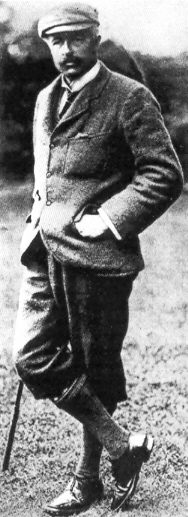
Horace Hutchinson
Horatio Gordon Hutchinson was born on May 16, 1859, the third son of a military man — General William Nelson Hutchinson. Horace first attended school at Charterhouse, where his grandfather had been headmaster. He was forced to leave due to poor health and later transferred to the newly established United Services College at Westward Ho!, two miles from the family home in North Devon. As a boy his family had been introduced to golf by his Uncle Fred, Colonel Hutchinson, who lived in Scotland and was Adjutant of the Fife Militia. ‘I used to hear a great deal of talk about this wonderful game, between my father and my uncle, the former having scarcely a more clear-cut idea of what it was like than myself.’ It was about this time that some North Devon locals proposed the golf course at Westward Ho!. ‘The course, as designed by those primitive constructors . . . started out near the Pebble Ridge, by what is now the tee to the third hole. Those pioneers of the game did not even go to the expense, in that instance, of a hole cutter. They excised the holes with pocket knives. The putting greens were entirely au naturel, as Nature and the sheep made them. Assuredly there was no need for making artificial bunkers. Nature had provided them, and of the best. Besides, were there not always the great sea rushes?’
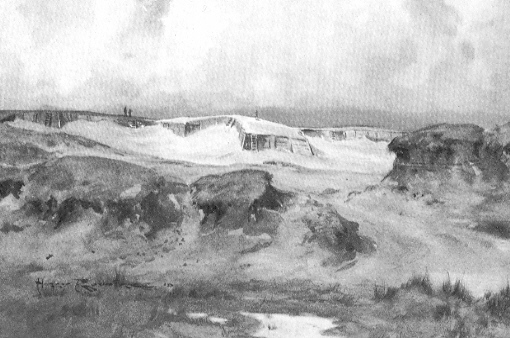
Westward Ho! by Harry Rountree
As a boy Hutchinson was given his first golf club by his Uncle Fred. Horace’s anxious mother asked Fred, ‘At what age do you think my little boy should begin golf: I want him to be a very good player?’ ‘How old is the boy now?’ his uncle asked. ‘Seven,’ his mother replied. ‘Seven! Oh, then he lost three years already!’ Horace went on to build a great reputation at Westward Ho! — at the age of sixteen he committed the ‘blazing indiscretion‘ of winning the club medal and by rule was named Captain, obligating him to chair all the club’s general meetings — the rule was amended the following year. In 1878 Hutchinson enrolled at Oxford where he proved to be an excellent all around talent, winning the University Cue at billiards, playing cricket and football, and together with the Scotsman Alexander Stuart made Oxford practically invincible in golf. During extended vacations from school he went on golfing pilgrimages, traveling north to Scotland and St. Andrews, and touring the handful of courses that existed in England — Hoylake, Blackheath, Wimbeldon, Felixtowe and of course North Devon. It was while on vacation from school that he often had as his caddie a young local lad who was also employed in the Hutchinson home — future golf great John Henry Taylor.
In 1882 Hutchinson left Oxford with a degree and the goal of reading for the Bar. Just prior to completing the Bar he began suffering from severe headaches, a continuation of a condition that plagued him his final year at Oxford. The doctors advised that he give up all reading for a time, ‘an instruction which I have observed rather faithfully up to the present’ he would write forty years later. ‘Their very wise counsel gave me all the more time for golf — the rules were not quite so headachy then and a man could play golf, or so it seems to me, with a lighter heart.’ His convalescence was spent at home on the links of Westward Ho!, as well as extended visits to Hoylake and St. Andrews, winning his first of eight St.Andrews medals in 1884. The following year Hutchinson reached the finals of the first Amateur Championship at Hoylake, falling to Alan Macfie, but in 1886 at St. Andrews he beat Henry Lamb by 7 and 6, and in 1887 he won again, this time by a single hole at Hoylake, in a magnificent match with hometown favorite John Ball.
It was in 1886 that Hutchinson launched his writing career with Hints on Golf the game’s first book of instruction. He would later write, ‘I perpetrated a book on golf. The only excuse to be made for it is that it was a very little one.’ Hutchinson originally sent the manuscript to a Mr.Blackwood and who consented to publish it, ‘for I am sure there must be something in that book. Ever since I read it I have been trying to play according to its advice, and the result is I’ve entirely lost any little idea of the game I ever had.’ The first and second edition soon sold out, and they decided to illustrate the subsequent volumes. Hutchinson later wrote that he was dancing with a young lady in London when he asked her if she played the game and she replied, ‘Oh, yes, we all play, and we learn out of a most idiotic little book.’
Hints on Golf was the first of over fifty books that Hutchinson would author. He may have began with golf, but he would ultimately write about almost every conceivable subject — including cricket, shooting and fishing; the subjects of natural history, dreams and mysticism; he was an essayist and a novelist; he attempted detective fiction; he was also very interested in history and wrote numerous biographies; and finally he expressed many of his most personal and intimate thoughts in Records of a Human Soul. It has been said that Hutchinson’s multitude of interests may have actually worked against him, preventing him from concentrating on his strengths.
And as wide and varied as were his interests, so to were his friends and acquaintances. Bernard Darwin wrote, ‘few men have been known to a larger circle or had more affectionate friends than Mr.Horace Hutchinson: he seemed to have been everywhere and to know everybody, and with his handsome presence and graceful kindly manner he had great power of making people fond of him.’ Prime Minister Arthur Balfour was a dear friend, they stalked deer in the forests of Strathconan and played many rounds together at North Berwick. He was very close to Old Tom Morris — Hutchinson’s unorthodox playing style reminded the old man of his lost son Tommy. Famous sportsman, Colonel Secretary and a political adversary of his uncle the powerful Prime Minister William Gladstone, Sir Alfred Lyttelton was a good friend and golfing comrade. Dr.Temple, the Archbishop of Canterbury, Lord Wolseley, esteemed military man and the ‘ill-destined genius’ Oscar Wilde were all acquaintances. The renowned banker, statesman and naturalist Sir John Lubock was another golf partner, Hutchinson would write his biography. He knew the scientists Charles Darwin and Thomas Huxley. He was very close with Sir Thomas Brassey the son of a railroad tycoon. Brassey was a well-known yachtsman and world traveler, as well as a long-time member of Parliament, and ultimately Governor of Victoria — Hutchinson often sailed aboard his famous schooner Sunbeam. And Hutchinson once found himself on the ground and ‘in an eleven’ with the great W.G.Grace, the storied cricketer and quite possibly the most famous man in all of England.
Another of Hutchinson’s very good friends was Cormell Price. Price attended Oxford in the 1850’s where he, William Morris and Edward Burne-Jones met and formed a bond that would last their entire lives. They had fallen under the spell of Oxford’s medieval beauty and John Ruskin’s newly published The Stones of Venice. From that point on they would follow their love of the arts, moving to London after obtaining their degrees, studying under the painter Dante Gabriel Rossetti and joining the Pre-Raphaelite Brotherhood — the group of artists formed in opposition the formulaic approach of the Royal Academy. Hutchinson wrote the PRB’s objective was ‘to present on canvas what they saw in Nature.’ In 1874 Price became the headmaster of the United Services College at Westward Ho!, the same year Hutchinson began his schooling. It is not surprising that Price as headmaster ‘recommended Ruskin’s books to the boys under his charge at Westward Ho!‘ (Rudyard Kipling was also a student at USC, and he credited Price with fostering his literary ability) The two became lifelong friends and Price’s influence can not be understated. It was through Price that Hutchinson was introduced to Morris, and although two were not friends, Hutchinson became a great admirer of Morris and the Pre-Raphaelite brotherhood. Hutchinson wrote, ‘If you look here, there, and everywhere you will hardly rest your eye on an object created since the day of Morris, which is at all worth resting it upon, that does not owe something, and very often the most important thing about it, to his genius. I say this, with full realization that it is saying a great deal. I do not believe that it is saying too much . . . But, apart from this or that form and colour that Morris has given for eyes to dwell on round about us, it is a bigger gift than this, a gift not of details but a general point of view . . . the appreciation that there is actually beauty which can make a difference in our lives. It is an appreciation which we know quite well to have been hid from the eyes of very many of our forefathers.’
In 1890 Hutchinson published what many feel was his greatest literary accomplishment and certainly his best known, Golf from the Badminton series. Bernard Darwin wrote,‘in 1890 he attained his full of stature as golfing prophet with the Badminton. I suppose his teaching is now [1955] largely outmoded, but if other teachers wrote half as well, they would not be nearly such bores as they often are.’ Ironically the publishers of the Badminton Library of Sport, which was a series on sports and pastimes, originally asked Hutchinson to contribute to a volume on Scottish sports, where golf would be included with skating, curling and tossing the caber. He convinced them golf was ‘of sufficient importance to carry a volume to itself’ Hutchinson’s Golf ushered in the golf boom in Britain.
That same year Hutchinson ‘took up rooms in London, near a studio, and began the serious study of anatomy and sculpture as a profession. It was an idea that conflicted a good deal with the whole-souled devotion to golf.’ Unfortunately, or perhaps fortunately for golf, he was struck ill and traveled to Biarritz that winter to recover. Even though maintenance of the course was crude to say the least, the golf at Biarritz — up and down immense cliffs — was invigorating. And although Hutchinson would continue to battle poor health through out his life, the holiday at Biarritz must have provided the medicine he required. When he returned he began work on the first book to depict the great golf courses of both Great Britain and Europe — Famous Golf Links — published in 1891. This beautifully illustrated book evidently satisfied his artistic urges, and golf again became his focus.
Hutchinson’s competitive career also continued. In the 1892 Open Championship at Muirfield he led by several strokes after the first 36 holes, it was the first year the championship was expanded from 36 to 72 holes, he tired and fell away on the second day. He continued to be a fixture at the Amateur championship, as well as contributing periodic articles to newspapers and magazines, and in 1896 he wrote After Dinner Golf in which he created the fictional character Colonel Bogey. At about this time Hutchinson also became involved in the formation of the Oxford and Cambridge Golfing Society. The idea for the Society was suggested at a dinner following a match between some former University players and the team from Oxford. It was modeled after the ‘wandering cricket clubs’ of the time. As Hutchinson described, the Society ‘had no club-house, no green, only a corporate existence and they said to the various Clubs, ‘Now, you give us the free run of your course and a free luncheon and other entertainment, and if you do this we’ll be so good as to come down and play a team match against your members and probably give them a jolly good beating” Horace Hutchinson was the Society’s for president, Johnny Low was the captain, Arthur Croome secretary, H.S.Colt and Eric Hambro were members of the original committee and Bernard Darwin took part in the first match.
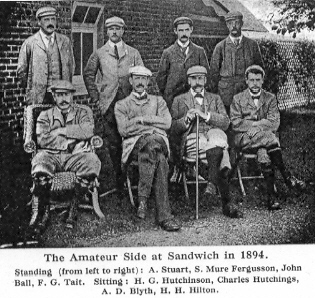
It was in 1897 that Hutchinson joined the fledgling periodical Country Life. Writing a weekly column for what would become the lifestyle magazine of Britain — from this platform his influence was immense. And although he covered all aspects of the game — competitions, rules, equipment, etc. — Hutchinson soon began to concentrate on the state of golf-course development, with the games popularity exploding he felt it important to focus on the new art of golf-architecture. Very little had been written about golf design, Willie Park-Jr. had briefly covered the subject in his The Game of Golf of 1896, and the relatively new magazine Golf Illustrated and its editor Garden Smith had touched the subject in 1898, but both were still advocating the formality common in the 1890’s — the static Victorian approach to golf design.
Hutchinson began in 1898 with a fascinating series on Britain’s great links in which he both analyzed and illustrated with photographs the qualities of these venues. The first installment was St. Andrews, followed by Prestwick, North Berwick, Sandwich, Hoylake and Westward Ho!. The final article was devoted to ‘Inland Golf’ and it was at this point that Hutchinson began to exert a critical eye. ‘There is no good reason why the putting on inland greens should not be as good as on any of the classic links . . . You cannot make your bunkers quite as good as the sand-pits by the sea, for these later have the peculiar charm of being Nature’s handiwork, which man can only imitate to a humble degree. If one may be allowed to criticise those shown in our picture (a photo featuring the artificial ramparts at Stanmore), one might say their imitation of Nature’s curves is scarcely as successful as it might be. They err, perhaps in being too stiff and straight. An irregular or S shape of outline would seemed more natural, and also it would have been better for strictly golfing uses . . . rather too uncompromising are these stiff and straight bunkers: and this not a criticism of those seen in the picture particularly, but of the great majority of bunkers artificially planned, for it seems that in only a few instances have our links gardeners had the gift of the artistic eye, or even of the unspoilt natural eye, for Nature abhors a straight line almost as much as a vacuum.’ A diplomatic, but clear critique of the state of golf design; first extolling the virtues of the natural links, followed by an illustration of the current trend’s weaknesses.
From this point on Hutchinson used ‘On the Green’ as a forum to analyze the finer points of design, publicize the work of the new breed of designers and generally promoting his vision of golf-architecture. Certainly there were numerous articles covering all aspects of the game, all the major competitions with special attention to the Amateur and Open Championship, rules and maintenance issues and a major emphasis on the effect of the new golf ball, but a significant percentage of the articles was devoted to new golf courses and the men who created them. Hutchinson brought on Scotsman A.J. Robertson, a talented writer and former editor of Golf Illustrated and a young Bernard Darwin from the Evening Standard. Hutchinson also invited numerous talents to contribute — Herbert Fowler was a regular guest, as was Harry Colt and the foremost greenkeeper Peter Lees, and many of the games great players, including Taylor and Braid. The trio of Hutchinson, Darwin and Robertson, along with the many contributors, provided Country Life with perhaps the greatest golf-writing talent ever assembled — and golf-architecture was a major beneficiary.
In 1906 Hutchinson edited the first book completely devoted to the science of golf-architecture and maintenance — Golf Greens and Green-Keeping. The book, published under the Country Life Library of Sport, gave Hutchinson an opportunity to explore the ideas and theories of the new movement in golf-architecture. H.S.Colt, Herbert Fowler, Peter Lees, C.K.Hutchison, Harold Hilton all contributed, with Horace Hutchinson adding three chapters of his own and providing a comprehensive analysis — weeding through and clarifying any of the inconsistencies of opinion among the contributors. In the book Hutchinson cited his most important tenets in laying out a links, as well as a providing examples of golf holes that illustrate those principles — Eden, Long, and Road hole at St. Andrews, the first at Hoylake, the 17th at Prestwick and 16th at Littlestone among them. At this same time Hutchinson wrote a similar piece for Country Life, a four part series entitled, First Principles In Laying Out Courses, some excerpts:
A question which will be asked is what the ideal mode and disposition of bunkers though the green (as distinguished for the moment, from which guard putting greens) may be. The easiest answer to this is, that variety is always pleasing, and that we do not wish always to have the same kind of shot to play.
Another of the principles which the layer-out of a course ought to place among the guiding maxims is the merit, especially as a guard to a hole, of a bunker running out diagonally into the course.
Bunkers guarding the greens should be deep and small, those through the greens by preference wide and shallow — yet not so shallow as to impose no penalty and make no demand on skill. We do not want to make the game less difficult than it is — rather the contrary — but we want to make the difficulties of such a kind that they give scope for skill in avoiding them and in getting out of them.
Take ‘Hell’ at St. Andrews as a good example of a bunker through the green. It is irregular in form, fairly large in size and has many outlets.
A certain amount of attention has been paid of recent years, in laying out courses, to give some reward to a correct placing of, as distinguished from the more correct directing of the tee shot, so as to make the second shot more easy, or to the correct placing of the second shot, in case of a long hole, in order to make the approach more easy, that is to say, to enable the player to get a run up ‘the entrance’ to the hole, instead of having to loft one or another of the guarding bunkers.
Very little attention indeed has been paid to the value of particular levels and gradients of the ground as practically performing the work of bunkers.
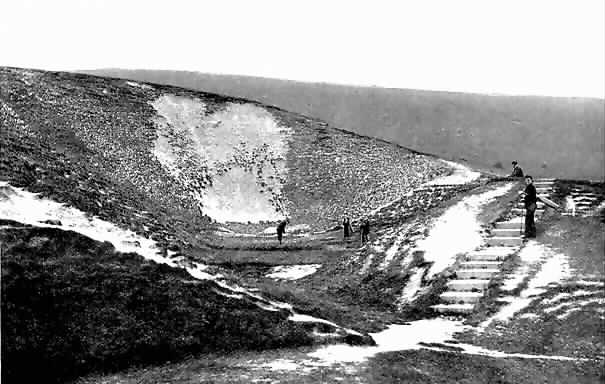
The Chalk Pit at Royal Eastbourne
Sound advice no doubt, but Hutchinson was more than a fine golfer and superb intellect, he was also an experienced designer. In 1886 his father had moved from Devon to Eastbourne in Sussex, and the following year Horace assisted a local gentleman in laying out the original nine of what would become the Royal Eastbourne golf course. The downland course was dominated by two natural features the cavernous ‘Chalk Pit’ and a bordering wood known as Paradise. Eastbourne was also infamous for its wild greens, Darwin would say —‘To putt at Eastbourne is art of itself. It is not that the greens are not good, for they are excellent, but the hidden slopes in them are . . . ‘extensive and peculiar.” One green in particular, the devilish ‘Paradise Green’, was noteworthy for its severe undulations — where according to Hutchinson, one could putt ‘ till the cows came home.’ Hutchinson collaborated with Holcombe Ingleby in the design of Royal West Norfolk in 1892, justly proud of the results he remarked ‘its distinguished features are the absence of artificiality and the great variety to be found in the holes.’ He would go on to design the nine hole links Isles of Scilly (1904) and was twice involved in revisions of Ganton (1905 & 1911), both occasions as part of some sort of gang action, involving the likes of Vardon, Ray, Taylor, Braid, Hilton and later Colt and Fowler. He was also involved at Le Touquet in France. His final design efforts can be found at Ashdown Forest where Hutchinson lived in lovely cottage Shepherd’s Gate (with garden designed by Jekyll) adjacent to the Royal Ashdown Forest course. Early on the banker Hambro, who controlled the land, asked Hutchinson to revise the old course, in fact there is some indication the cottage was a part of his payment, and several years later he would design what became known as the new course. Like Eastbourne, Ashdown Forest was known for its ‘very curly and puzzling putting greens.’ This experience provided Hutchinson with credentials beyond just that of a great player, it was from this foundation that Hutchinson the golf-architectural theorist and critic was able to influence:
The laying-out of golf courses is such a perpetual process that we need offer no apologies for a further hint or two on that inexhaustible subject. There is one point which even the most advanced of the links architects seem often to have missed. It is in respect of the right placing of bunkers through the green for the punishment of the indifferent tee shot. Very often we see bunkers place on the right-hand side of the course and another on the left-hand side, with a channel left between them down the centre . . . This is an arrangement which has neither equity nor interest. If one of these bunkers, it does not matter which was pulled back some fifty yards nearer the tee, so as giving a chance of carrying it, it is obvious at once — that the shot would gain interest.
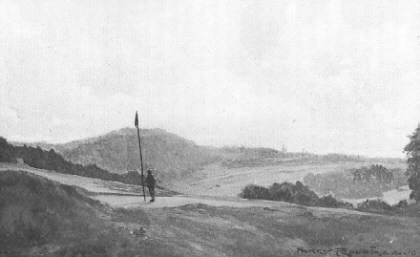
Natural features dictate play at Royal Ashdown Forest.
Too much of a dead level is unprofitable, and here and there, say twice in the round, we may even do with a ‘blind’ shot. If it be a long one . . . And then we should remember that, since we seldom play in a dead calm, we shall get much more variety from a course which dodges here and there, with holes across and right angles to one another, than on one which goes straight out and in so the that the wind is coming at the same angle all the outward half, and, again, at the same angle (opposite the former) all the inward half.
‘A good natural course’ is rather a hackneyed expression by this time, and yet to apply it is, on the whole, to praise highly. We know that if we go to a course that is so described we shall almost certainly have a pleasant day . . . Naturalness in a course also implies holes guarded by natural hazards, and more particularly by natural turns and twists in the ground designed by the hand of Providence to tease the cut-and-died approaches.
We are in danger of monotony on the course which any one of these, or other, artificers plans for us, because they follow good principles too religiously. My view is that a bad hole here and there, such as a pot hole — say, the seventeenth at Sandwich — is not out of place at very rare intervals. Even over a golfer who is all good we rejoice when he makes a lapse. Some years ago the idea was at every hole to give a man a cross bunker to pitch over. Then it was realised that this was not a good principle for repetition eighteen times in succession. There was an outcry against such bunkers, and now the tendency is never to give us one at all. That is a mistake. We want at least a couple of them in eighteen holes, according to my way of thinking.
Schools of golf architecture are divided into the disciples of those who make grass-sided bunkers and those who make them with a steep cliff of the local soil. But why make all of one kind or the other? Why not a mixing up and variety?
The first thing to appreciate, by way of shield against this danger, is that the sauce of golf is its variety. When you hear this wiseacre and that saying that there ought to be no cross bunkers, another that there ought to be no running-up shots, and so on, you may know at once they must all be wrong. Such worlds as ‘none’ and ‘all’ should not appear in the laws laid down, for these matters. We want a little of each — ‘two pen’orth of all sorts,’ like the cabman’s morning drink — some lofting approaches, some run-up and so on with the rest of the puzzles.
In any case that is the right end, that a tee shot, if placed correctly, shall give an easier second, than if not correctly placed. It is an idea to be held in my mind by all planners of greens, second in importance to one other, namely, that no one idea shall be allowed to obsess the mind in so planning to the exclusion of others. It is the following, without relaxation, of one idea, however good in itself, that makes courses dull with all the dullness of artificiality; it is only by combining all ideas that are not bad that one can get anything like the infinite variety of Nature.
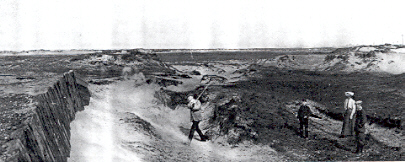
Brancaster
Hutchinson’s theories can be summarized as follows. He believed that a limited amount of blindness was acceptable, but never blind approaches, but then excuses an occasional blind approach if they are ‘full shots’ or long approaches for the ‘sake of interesting variety’ , he felt there was place in the game for what he called ‘pleasurable uncertainty.’ He condemns as a rule cross-bunkers, promoting diagonal bunkers and bunkers en echelon (or staggered bunkering) because of the choices they provide, but then at the same time he says don’t take this too literally because the aerial shot is exciting and variety is king. He believed that a well designed course should give the accurate driver ‘the just value for the correctly placed shot,’ but at the same time was not opposed to severely punishing an inaccurate approach. He promoted the use of ‘floral hazards’ — especially as side hazards and the corner of doglegs — at time when a tree on a golf course was thought to be blasphemy. He promoted the incorporation of the native surrounds, the use of whins, heather, long tussocky grass and other native growth between tee and fairway ‘to catch and punish a topped drive’ and around the margins of the ‘mown and well-kept sward, between the ‘pretty’ as modern people are in the fashion of calling it, and the ‘ugly’ original jungle.’ Hutchinson was a was major proponent of the idea of ‘the ugly original jungle‘ — ‘the bent grass looks a bit artificial and regular, but no doubt in time it will look as wild and terrible as need be.’ One could almost conclude that Hutchinson contradicted himself on almost every important point, but that apparent paradox is understandable when you consider his overriding rule for interesting golf-architecture was variety. He believed the ancient links were interesting because of their variety, variety which was a result of a natural evolution, and that man-made rules for design must be flexible to account for the haphazard nature and unpredictability of Mother Nature.
Not only was Hutchinson instrumental in elevating the art of golf design, he was also actively promoting the artists whose work he admired. ‘What I should rather like to see is a golf course laid out and bunkered by consigning six holes to Mr.Colt, six to Mr.Fowler and six to Willy Park. I name these because they seem to me to have the most distinct and different styles.’ Hutchinson also provided a forum for many architects to express there thoughts and observations, allowing them to contribute on a regular basis. Fowler was a frequent guest, writing about every thing for plastisine models to analyzing the Open venue at Deal to defending the criticisms of his work at Westward Ho!. Colt was equally active, interestingly even contributing an article on club-house architecture. Harold Hilton, J.H.Taylor, Tom Simpson, Alister MacKenzie, C.K.Hutchison, John Low, Stuart Paton, John Abercormby, and C.B.Macdonald were either contributors or the subject of major features. James Braid produced a three part series on ‘The Planning of a Golf Course’, in which he put forth his very formulaic approach to design, which was followed the next week by a short rebuttal by Hutchinson, ‘We are becoming a little wiser than we used to be, and Braid’s recent articles show especially how much wiser our professional brethren are becoming than they used to be, in the problems of laying out courses. We have hunted the matter much closer down to its first principles and realise much more fully the qualities which make a course difficult, interesting and a good and just test of golf. There is only the fear that as we become more scientific we may fall into the worse pit of becoming altogether undramatic. It is not the least necessary that it should be so: if the science is applied properly it ought to have the effect of adding more than a little to the dramatic interest; but unless that interest is kept before the eye of the linkscape gardener he may turn out a good, but deadly dull job.‘
During the coverage of the 1906 Amateur Championship, Hutchinson introduced what would become an on going feature, the National Golf Links of America project and its founder C.B.Macdonald. Macdonald had been inspired by the‘Best Hole Discussion’ article in Golf Illustrated to create his ideal course. He had competed in that championship at Hoylake (along with Hutchinson, Colt, Fowler, C.K. Hutchison, C.H.Alison and Guy Campbell), but his main objective was the study of the finest holes in Britain in preparation for his dream course. Macdonald spent a great deal of time interrogating Hutchinson and his influence is apparent in many of the holes Macdonald ultimately chose to replicate. In 1910 Hutchinson came to America to visit his good friend, starting his journey in England with Lord Brassey on his yacht Sunbeam, they first dropped anchor at Dornoch, followed by Iceland, New Foundland, New Brunswick and finally Montreal. After a golf tour of Quebec, he met Macdonald in Boston and proceeded to play Essex County, Myopia Hunt, The Country Club, Baltusrol, Garden City, Maidstone, and finally the National Golf Links still under construction. Macdonald would recall, ‘Together we made a study of the National, and I received much valuable advice. I listened attentively to everything he suggested — where the bunkers should be placed, where the undulations should be created on the putting-greens, etc, etc. I know he impressed on me that the human mind could not devise undulations superior to those of nature, saying that if I wished to make undulations on the greens to take a number of pebbles in my hand and drop them on a miniature space representing a putting-green on a small scale, releasing them, and as they dropped on the diagram place the undulations according to their fall. This I did for some of the National greens where I had no copies of the original undulations which nature had made on the great greens of the world.’
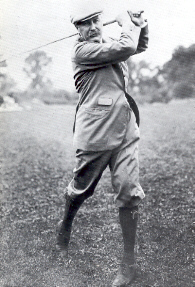
C.B. Macdonald
When Hugh Wilson and George Crump separately sought Macdonald’s advice for their respective projects of Merion and Pine Valley, he advised both to travel to Britain to survey and study her great courses, which they both did in 1910. It would seem reasonable that Macdonald assisted both in planning their tour, recommending outstanding courses and individual holes for study, just as Hutchinson had recommended to him, and it seems very likely he brought them into contact with the great man himself. A third man journeyed to Britain in the summer of 1910, Donald Ross took three months to visit family in Dornoch, to compete in the Open at St. Andrews, and to study. ‘While abroad he intends to play most of the leading courses and not only that, but to make a study of them, seeing for himself their best features and seeking information from members, greenskeepers and others about their construction, upkeep and other details.’ That likely involved looking up Hutchinson, who had produced the pre-eminent book on the subject — Golf Greens and Green-Keeping — Hutchinson was a member of St. Andrews, as were the other important contributors Colt and Fowler, and they were no doubt on hand for the Championship. Having recently moved to Essex County, it is also quite possible that Ross may have crossed the touring Hutchinson and Macdonald’s path prior to his trip abroad.
The decade before the Great War was bitter sweet for Hutchinson. In 1908 the Royal and Ancient elected him as their Captain — the first Englishman to be so honored. ‘As one of my wife’s relations was good enough to say— ‘ I’m glad they’ve made Horace that — it will look so well in his obituary notice’.’ Unfortunately that humorous note was not the far from the truth, Hutchinson’s health had always been a concern, he was constantly battling bouts of ‘influenza’ and his competitive game suffered. In 1909 he was stricken with his worst attack to date, and in 1913 Horace Huthinson had a very ‘severe operation’, so serious that it was thought he would not survive it. He did survive but it made it impossible for him to play golf again. It also forced him to leave his home in the country Shepherd’s Gate, the pretty house overlooking Ashdown Forest and move back to London. In 1914 he would write his reminiscences of golf — Fifty Years of Golf — published after the war in 1919, it was the last book Hutchinson would write on the game he loved so much. Horace Hutchinson died in 1932.
When considering the great theorists who influenced the art of golf design, Horace Hutchinson normally gets no more than passing mention. He is not known for complex theories on strategy, his ideas were simple — provide the golfer with choices. Above all he preached the importance of nature and variety, the same message sounded by Ruskin, Morris and the Arts and Crafts movement. Strategy, naturalness and variety were all alien to those early golf courses of the Victorian era and Hutchinson was responsible for rescuing the game from what might have been a fatal deterioration. You might ask why is he not better known, and the answer is partially due to timing, his impact was very early and after the Great War many of his simple views were considered antiquated and old-fashioned. His theories had been expressed just after the turn of the century and Hutchinson had long abandoned his platform by the 1920’s when many of the most prominent essays on design were being written. But his impact can not be overlooked; his simple theories still hold true. Horace Hutchinson is the father of the art of golf-architecture.
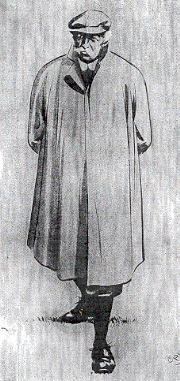
The Guide
Hutchinson said this just prior to the Great War, ‘It would be very dull and futile business to go into all the development of the inland golf which went on during these years. Enough has been said. But you could not draw anything like a full picture of the golf of the last fifty years without noticing this development. The inland Clubs, and especially those about London, have become a force. As their members go forth to play from the big City which is the common centre they are the better able to make their opinion felt; and their word has become of importance in modern golf. It is possible that is destined to have a larger importance yet. But I have no business with prophecy.’
Part IV
Lamplighters
Like so many successful Londoners of the 1890’s, Tom Roberts looked to the countryside as an escape from the dreariness of the city and in 1897 built a home called Ridgemount in the Surrey heathlands. Roberts had leased the land from St.John’s College, Cambridge ‘who had obtained Sunningdale Estate in 1524 from the Benedictine Nunnery of Broomhall which was suppressed by Henry VIII.’ As a member of a growing throng who had been bitten by the golf bug, Roberts came up with the bold idea of creating a golf course on this God forsaken land of heather, gorse and pine trees. Roberts approached St.John’s College with a plan of ‘making a golf course and the creation of leaseholds on the land roundabout for building a good class of house.’ Surprisingly they agreed and Roberts then turned to Willie Park-Jr. (1864 -1925) of Musselburgh to lay out a golf course on this agricultural wasteland.
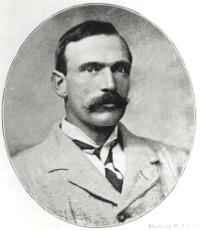
Willie Park, Jr.
Young Willie Park had won the Open Championship twice, in 1887 and 1889, but was relatively unknown outside of his native Scotland. Park was certainly an experienced golf-architect having tutored under his father, Old Willie. He had also broached the subject in his book The Game of Golf in 1896, but it was a minor note and his ideas were not fully evolved. Park’s selection probably had more to do with his agreement to design and construct the golf course for a fixed fee of £3,800 — a major gamble considering the uncompromising nature of the site. Harold Hilton wrote that Park was ‘the first man to take on a contract for the laying out of a course on heath land, which to the casual observer seemed to be particularly unadapted to the project at hand.’
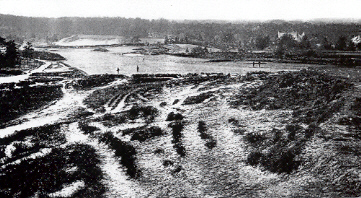
The fifth at Sunningale Old.
Work began in 1899. Park recalled, ‘When we started on Sunningdale it was nothing but a mess of rough heather and dry sandy soil. There was not a blade of grass to be seen, and well I remember Hugh Mclean, the Scotchman, who is the greenkeeper, saying to me, ‘It is like trying to cheat Providence attempting to grow grass here’ — and so it was. It was a fearful job at Sunningdale, and at the ninth hole the men said it was impossible to take the heavy manure up the steep hill. I told them it must be taken up, even if they carried it in teaspoonfuls. The ninth green is looking all right now I think, but we killed two horses in the undertaking.’
While the difficult work progressed at Sunningdale, Willie became involved in a second project — Huntercombe. Located on the western end of the Chiltern Hills near Oxford, Park had first discovered the property a few months after he began at Sunningdale. He invested £5000 of his own money and organized a small group of eight investors who put up another £1200. The site was more open and less rugged than Sunningdale, consisting of ‘grassy open spaces interspersed with heather, gorse and blackthorn.’ Construction commenced in the fall of 1900 with Hugh McLean now supervising construction of two courses, he ‘used to put his bicycle on to the train at Sunningdale from Reading and cycle up to supervise the work at Huntercombe.’ Thankfully for McLean, with more favorable terrain the construction at Huntercombe progressed fairly quickly.
After two years of construction the golf courses were ready for play in 1901, Huntercombe in May and Sunningdale in September. Willie Park had reversed a terrible trend and shown that it was possible to build an inland golf course comparable to the great seaside links. It was remarkable achievement producing not just one revolutionary design, but two. Horace Hutchinson wrote of Sunningdale, Park ‘had certainly produced the best thing in the way of an inland course that up to that time had been created.’ Walter Travis a great admirer of Park said of Huntercombe, ‘I consider that Huntercombe is easily the best laid course that I have ever played over anywhere.’ Harold Hilton agreed, ‘In links architecture his two great creations have been Sunningdale and Huntercombe and of the two I am distinctly inclined to look upon Huntercombe as the greater effort of the two.’ Although there wasn’t agreement on which course was superior, it was universally agreed that Willie Park had set a new standard in the way of inland golf.
In 1901 Willie Park-Jr. moved his home from Musselburgh to Huntercombe — his business affairs were now centered in London. A few years earlier he had moved his equipment enterprise, Willie Park & Son, south to take full advantage of the golf boom. Park was an extraordinary talent — a champion golfer, a talented craftsman, an inventor and innovator, an astute businessman, and a master self-promoter/advertiser. He was also universally well-liked. ‘He was a big man in every sense,’ not only big physically, but also in modesty, generosity and intellect. Hutchinson was an admirer, ‘few professional golfers are so universally liked as Willie Park and we may say with truth that he is a man without a single enemy.’ He had great respect for Park at time when professionals were considered second class citizens and hardly the social or intellectual equal to ‘the amateurs.’ ‘A distinctive magnetism sensed by the many kinds of people with whom he came into contact,’ Willie possessed a charm and charisma that endeared him to many, as Garden Smith editor of Golf Illustrated wrote at the opening of Huntercombe, ‘Those who know Willie Park will wish him all the success in his knew enterprise. There is probably no professional golfer who commands so much respect and even the affection of all classes. He is the embodiment of all that is thorough and upright and a venture of which he is the guiding spirit is assured from the start.’ For the next several years Park would devote all his energies and most of his considerable wealth into the development of Huntercombe.
From golfing and social standpoint, the club and the course were a great success. Among its membership were Lord Arthur Balfour, Prime Minister 1903-05, the Earl of Chestefield and Lord Herbert Vance Tempest. Edward Hudson and George Riddell of Country Life were not only enthusiastic members, but were also among the original group investors, in fact Hudson had lined up several talented architects for the surrounding housing development. And the list of well-known amateurs that Park attracted was impressive — Robert Maxwell, J.S.Worthington, Stuart Paton, C.K.Hutchison, J.F.Abercromby and C.H.Alison. But despite the critical acclaim Huntercombe suffered from serious financial difficulties, the planned real-estate development never took off due to its awkward location — a little too far from London for cars and six miles form the nearest railway station. George Riddell arranged a temporary bailout, but unfortunately in 1908 Huntercombe went into default; Willie Park lost a small fortune. Near the end Horace Hutchinson wrote, ‘all golfers who know the attractive charms of the Huntercombe course will learn with regret that some difficulty have intervened lately to hinder the continued prosperity of the club. The course is so good, and the situation so picturesque for all city dwellers, that it would be a thousand pities were the efforts of Willie Park in creating the course, and of those members of the club who have for years fostered the game here, to go for naught.’
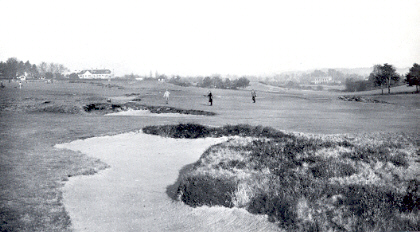
The features employed by Willie Park at Sunningdale were natural in appearance.
Despite the financial set back, the excitement generated by the heathland breakthroughs created a tremendous demand for Park’s design talents. He was involved with one major commission after another — Notts, La Boulie, Formby, Montrose, Mont Angel, West Hill and Knocke were all produced in the first decade of the century. And when Huntercombe member J.F.Abercromby, with no practical design experience, was asked by a wealthy financier to plan a championship golf course, he naturally turned to Park to design and build Worplesdon in1908. That success resulted in a second commission and collaborative effort the following year — Coombe Hill (1909). And Huntercombe and Sunningdale were not the only projects involving golf and the construction of country homes, there were several resort projects where Park had occasion to cross paths with Arts and Crafts architects, with Arnold Mitchell at Ostend (1903) for the King of Belgium, Edwin Lutyens at Knebworth (1908) for Lord Lytton, and with a number of architects, including C.F.A. Voysey, at the seaside resorts of Aldeburgh (1906) in Suffolk and Frinton-on-Sea (1904) in Essex.
Although Willie Park wrote two books, they were almost exclusively focused on playing the game. But he did briefly touch on the subject of design and through those books and a few rare articles, one can discover his philosophies. And his design principles reflect the Arts and Crafts ideals of simplicity, an appreciation for the past and a respect for nature, all echoed by Hutchinson:
The shape of the course must be decided by the nature of the ground.
The selection of putting-greens is a much more difficult matter. They may be on the level course, or in a natural hollow or basin, provided it be sufficiently large and shallow, or they may be placed on the tops of large ‘tables’. All of these are good positions, and the more variety that can be introduced the better.
A golf architect must approach each bit of country with an absolute open mind, with no preconceived ideas of what he is going to lay out, the holes have to be found, and the land in its natural state used to its best advantage. Nature can always beat the handiwork of man and to achieve the best and most satisfactory results in laying out a golf course, you must humour nature.
At a time when Victorian golf-architecture was suffering from mathematical precision, symmetry, artificiality and a total lack of imagination, Willie Park was able introduce the qualities which had been exclusive to golf by the sea — variety, strategic thought and use of natural features. By adopting the changing aesthetic tastes and introducing them into golf design, Park revolutionized golf-architecture. He would remain extremely busy designing new golf courses throughout his life, shouldering an enormous workload on his own, for unlike his contemporaries he never took a partner. With the economic slowdown following the First World War, Park brought his skills to North America, designing or redesigning over seventy courses in a period of only eight years — a bewildering number, so many, he was forced to end his golf equipment business. Sadly in 1923 Willie was showing signs of loosing touch, sometimes appearing with a gang at a job that he had already completed. Later that year he suffered a complete mental breakdown and was taken back to Musselburgh where he died in May of 1925. Willie Park had worked himself to death.
Sunningdale and Huntercombe awakened the world to the possibilities of inland golf, and among those inspired was Henry Cosmo Bonsor. Bonsor, director of the Bank of England, overcame legal restrictions on turning an open heath into a golf course by arguing successfully that he held the manorial rights of Walton Heath adjacent to his home at Kingswood Warren. Cosmo Bonsor then turned to his brother-in-law, W. Herbert Fowler (1856 -1941) a fine amateur golfer and a golf design enthusiast, to transform his dream into reality. And in 1902 Herbert Fowler relocated along with his family to Walton to take on the project. With a huge tract at his disposal, Fowler explored the site upon horseback for several months. ‘It was all covered with heather of the most robust nature, some two to three feet high, and where there was no heather there were masses of giant whins; but the drainage was good, and the glorious open space, with no trees or ditches, and the rolling ground is here broken up by chasms, which promised to make capital natural hazards . . . having thoroughly examined the whole of the heath, and eventually decided to make a golf course on it, the next thing to do was to settle where to go. We had 600 acres available, and most of the ground was very suitable, but eventually I came to the conclusion that I would go out by way of a spot which appealed to me as promising two extra short holes, and that, in view of making the upkeep of the green easy, I would keep the outgoing and incoming courses fairly near together.’ After settling upon and marking out a routing, the area was cleared of the heather and whins, followed by steam ploughs to break up the ground. Turf was sown and the course was playable by the end of the year — the bunkering would be added after the first season and the course was complete in the spring of 1904.
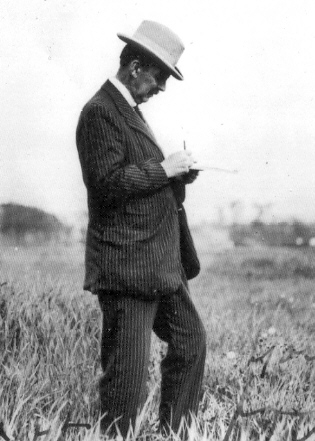
Herbert Fowler
Walton Heath immediately drew praise from all corners. Hutchinson wrote, ‘Another point in the golfing history of the week was the opening of the new course on Walton Heath. The heath is a delightful place close to the Kingswood Station, only sixteen miles from London, and some 700 ft. high. It is covered with heather and gorse, and if there are no grouse and black game, there ought to be. There are rabbits and partridges, and now there are also golfers. The course has been very well laid out—all steam-ploughed and sown, and they have been at much pains, which has not failed in its effect, to get the right sort of grass.’ He would later write, ‘Sunningdale has always seemed to me just about the best of the inland ones. Then I was at Walton Heath, as a guest of Mr.Cosmo Bonsor’s kindly hospitality, when that great inland course was opened . . . Walton Heath was a monument to the skill of the other of our amateur course constructors, Herbert Fowler. He made a very good thing of it, as the wonderful success of that Club has testified since.’ As the club was clearly successful, George Riddell of Country Life — having already negotiated for the land around the clubhouse — bought out Bosnor and took over in November 1905. In 1906 Edward Hudson approached Edwin Lutyens to design the Dormie House, ‘with a Jekyll garden of roses, foxgloves and other homey summer flowers.’ In the plot next door Lutyens built Chussex for Herbert Fowler. Named for Chussex Plain, an area in the center of the course where Fowler had carefully left untouched the remains of a Roman Villa. Fowler wrote,’The Romans, I found, had been there some years ago, and they had designed some excellent bunkers, which I was first told by archaeologists were used as stables, but now higher authorities say that they were camp kitchens; anyway, they come in capitally in forming the best type of hazards.’
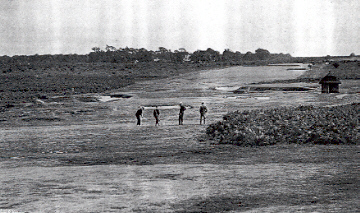
Walton Heath’s well bunkered sixth.
The great champion James Braid was brought on as professional and remained at the club his entire life, which included his own busy career in golf design. Darwin wrote, ‘It was a curious fate that he should live and play for so many years of his life on two of the best inland course, the Old and the New at Walton Heath, and yet have little or no hand in the designing of them. After Herbert Fowler’s death he would no doubt be consulted as to any changes, but as long as Mr.Fowler was there, I doubt if anybody else had much to say in the matter, for he was not only a most accomplished architect, with a touch of genius, but also an instinctive despot.’
The success of Walton Heath led to a string of important commissions for Fowler. In the next several years he would complete an impressive list of designs and redesigns, including Southerndown (1908), West Surrey (1909), Delamere Forest (1910), Ganton (1911), Cooden Beach (1912) and a second course at Walton Heath (1913) of which Darwin said ‘there is a heather . . . which would certainly withstand a charge of dynamite and possibly even the power of Braid.’ Like Willie Park before him, he too assisted J.F.Abercromby with a design — this time West Kent (1914). However Fowler’s most famous, or perhaps infamous commission was his complete redesign of Westward Ho! (1908), a project that garnered both enthusiastic praise (including from its native son Hutchinson) and severe criticism, most notably from a letter published in The Times from an ‘old golfer’ using a pseudonym. Fowler responded by writing a detailed article describing the numerous changes made to the course, their positive effect, while at the same time correcting much of the letter’s faulty information. In 1910 Fowler took on Tom Simpson as a partner, who would be involved with several prominent designs of his own, including the remodeling of Cruden Bay (1911).

Darwin holding the President’s Putter
Bernard Darwin described Fowler’s designs in this way, ‘the work of Mr.Herbert Fowler, who is perhaps the most daring and original of all golfing architects, and gifted with an almost inspired eye for the possibility of a golfing country. He is essentially ferocious in his methods, and there is no one else quite so merciless in the punishing of shots that quite respectable, that are in fact so nearly good that the striker of them, in the irritation of the moment, calls them perfect.’ Horace Hutchinson had a similar perspective, ‘Of all the bunker-makers, Mr.Fowler is perhaps the most ferocious, since he will plant a difficulty just the least bit nearer to the hole than any other ‘architect’; for the shot that is nearly good he has little mercy.’
Following the Great War, Herbert Fowler expanded his firm to four, adding Abercromby and Arthur Croome. With a struggling economy slowing domestic design, Fowler made an extended tour of the United States in the early twenties. He was involved in such designs as Del Paso, Presidio, Seqouyah and LACC North & South (with George Thomas supervising construction), all in California, as well as the dramatic Eastward Ho! on Cape Cod. He was also responsible for transforming the 18th at Pebble Beach from a relatively benign par-4 to the world famous three shotter we know today. Although the home market for golf design would never reach the heights of before the war, he continued to produce a number of impressive works in Britain, the most famous being the two courses at Saunton (1919/1935) and the Red and Blue courses at Berkshire (1928). Darwin was particularly impressed with his design for the new course at Saunton and cited it as one the few modern seaside designs of note, ‘There is scarcely a piece of ground anywhere more ‘obviously designed by Providence for a golf course’ than is Saunton. I always remember with joy a sentence in an old book describing how the wind ‘doth play the tyrant in this tract’. In the course of its tyranny it covered up, I believe, an entire church and it certainly made noble hills and valleys. There is one hole on this new course where the player is bidden to drive at the last remnant of a submerged civilisation, an ancient fragment of a tree, I think a sycamore, still keeping its head above the mighty sea of sand.’ And of the Berkshire courses he said, ‘ The country is essentially undulating and interesting and full of natural beauty. These two courses were laid out by Mr.Herbert Fowler, who had as an architect an ‘eye for the country’ second to none. He made up his mind very quickly, for even as he looked at it a waste of trees and heather seemed to arrange itself in a pattern of holes and his original scheme, to the ordinary eye miraculous arrived at, wanted very little revision. The Berkshire courses have more of charm perhaps and less austere grandeur than Walton Heath. Walton and Saunton are the two best memorials to Herbert Fowler, but the Berkshire makes a worthy supplement to them.’ Herbert Fowler passed away quietly in 1941 near his crowning achievement Walton Heath.
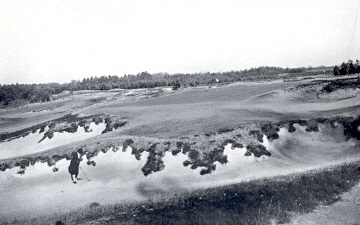
The thirteenth at Berkshire Blue.
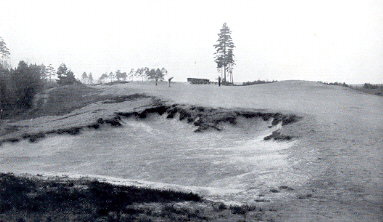
The fourth at Berkshire Red.
Herbert Fowler was not a prolific writer, he never produced a book, and only contributed to one, Hutchinson’s Golf Greens and Green-Keeping. He did however write several articles and from these one can see that he too was influenced by both the Arts and Crafts movement and Hutchinson:
In making bunkers it is, of course, most important to avail oneself as far as possible of any help the natural formations of ground may give . . . For myself, I should always try to find a spot where the tendency of the run of the ball would be to lead to the bunker. This enables a smaller hazard to do the work of a much larger one, and it is only carrying out a principle which obtains on the older classic courses.
Only general advice can be given as to the placing of bunkers on a course, and certain principles should be observed. Much always depend upon the formation of the ground and natural features, and the arrangement of the bunkers should vary slightly at the different holes so as to avoid monotony.
Now that the ball-makers have successfully ruined most of our leading course, it remains for the golf architects to so design the greens that they shall be both difficult of access and that the putting shall demand care and skill in judging slopes and undulations.
Unless there is some natural feature which will form the entrance, sand bunkers should be constructed, slightly in advance of the green proper, on the right and left side of the entrance . . To my mind there should, if possible, be an entrance to all greens. By this I do not mean bunkers, placed with mathematical accuracy exactly opposite each other.
God builds golf links and the less man meddles the better for all concerned.
While Young Willie Park’s work was progressing in the summer of 1901, the Sunningdale Committee advertised for a Club secretary. They received 435 applications, whittling those down to five candidates, before finally selecting a most qualified individual — a former member and captain of the Cambridge golf team, R & A member, winner of two Jubilee Vases, member of the Rules of Golf Committee, qualified solicitor, past secretary of another new club, with a knowledge of golf course design and greenkeeping — his name, H.S. Colt (1869-1951). Colt, the son of a London Barrister, had been practicing law for the past seven years in Hastings, a small coastal town in Essex. And although the law was his chosen profession, golf dominated his life. He was a nationally renowned and active amateur competitor; a founding member and the designer of the golf course at Rye; the secretary of that same club for three years, overseeing the improvements to the course throughout the 90’s. The move Sunningdale was a natural.
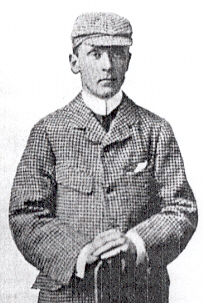
Harry S. Colt
Following Sunningdale’s opening in the Autumn of 1901 Willie Park-Jr. severed all formal ties, understandably wanting to concentrate his efforts at Huntercombe. This provided Harry Colt with a relatively free hand in refining the golf course. His first taste of golf design had come in 1894, when he designed Rye with the assistance of Douglas Rolland, a wonderful course that sat in relative obscurity for many years. He also served as the clubs first secretary and captain, supervising on going improvements to the links. But his design activity was limited to his home club and possibly the nearby Hastings & St.Leonards, but he was certainly not an active golf architect.

Rye’s ‘Soup Bowl’ — the eighteenth.
It is not known exactly when Colt’s formal design career began. His last improvements to Rye were in 1901 — supervising the construction of several new tees reinforced with sleepers — the same year of his Sunningdale move. At Sunningdale he and the greenkeeper Hugh MacLean implemented minor improvements almost from the start. It appears his design of the new course at Hendon outside London in 1903 may have been his first as a golf-architect, it is known in 1904 he requested permission from Sunningdale ‘to take up other work if offered.’ In 1905 he thanked the committee for granting him a leave of absence, most likely for the design of the Prenton course near Liverpool. The following year was extremely busy, a semifinalist in the Amateur Championship, becoming an agent for Shanks Mowing Machine and contributing an essay to Hutchinson’s Golf Greens and Green-keeping — the oft mentioned landmark book devoted to golf-course design and maintenance. Colt’s chapter was entitled ‘Treatment and Upkeep of a Golf Course on Light Inland Soil’ and included practical advice on acquiring land, analyzing soil, mapping, routing and design, construction, drainage, establishing turf and maintenance. His involvement in this book, which included chapters written by Fowler, Braid, Hilton, Mure-Fergusson, Hutchison and Hutchinson, not only provided Colt with exposure and legitimacy but also confidence, eventually leading him to concentrate all his energies on golf-architecture.
Unlike Park and Fowler who started with a splash, Colt’s start was more modest, his rise steady and consistent, not unlike his personality and the quality of his work throughout his career. But starting in 1907 his design career began to accelerate. Colt’s first noteworthy project was a major alteration of Sunningdale. Horace Hutchinson wrote, ‘Many critics of golf course, the writer among them, have always had three serious objections to the Sunningdale course, as originally laid out. In the first place its short holes seemed poor; in the second place the seventh and eleventh holes seemed too blind and flucky; and in third place, the last two, especially the seventeenth, seemed feeble. It appears probable that in a year or two no golfing critic will be able to raise any of these objections, for alterations and improvements have been made, or in the course of being made, in the direction named.’ The process perfected Park’s revolutionary design, it was now not only a golf-course that had turned the tide of design, but it was now, thanks to Colt, a model of enduring excellence. And in his typically selfless manner, when given credit for improving Sunningdale, Colt wrote letter to Willie which was eventually published:
From a letter appearing in this week’s issue of ‘Golf Illustrated’ it seems that a statement has been made to the press, taking away from you the credit for laying out the Sunningdale golf course. I write to tell you that, if this be so, it was done without my knowledge in any shape or form. The above mentioned letter gives you every credit for laying out the course, which is your due without a shadow of a doubt. And, if I may be allowed to say so, no one appreciates your work at Sunningdale more than myself, nor the difficulty of forming a framework of really good course. Please make any use which you like of this letter.
While the improvements progressed at Sunningdale, Colt was hired to advise on the new course at Alwoodley and it was here that he met Alister MacKenzie in 1907. From this point until the outbreak of the War, Colt was the busiest golf architect in the world — designing, redesigning and building over 50 courses. In 1908 his prominent designs were Stoke Poges near London, Sandy Lodge with Harry Vardon and the Forest course at Le Touquet, his first continental design. He also took on an assistant, C.H.Alison, who was the secretary of Stoke Poges and like Colt a prominent amateur golfer. 1909/1910 saw Northamptonshire, Denham and perhaps Colt’s favorite design — his ‘least bad golf course’ Swinley Forest. With so much of his time devoted to golf-architecture, in January of 1911 Colt resigned his position at Sunningdale and free from responsibility, traveled to North America to design Toronto and the CC of Detroit, as well as revising Ganton back at home in England.
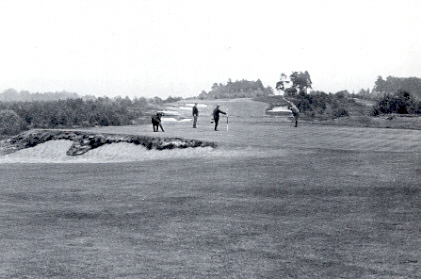
The eleventh at Swinley Forest.
The Book of the Links was published in 1912 edited by the seed merchant Martin H.F. Sutton. Colt had been put on retainer by Sutton and Sons in 1909, so it was natural that he would be involved with this book devoted to design, construction and maintenance. In fact Colt was the most important contributor, writing two thoughtful chapters — ‘The Construction of New Courses’ and ‘Golf Architecture’. The remaining chapters were written by Sutton, Bernard Darwin and the ubiquitous George Riddell, but it was Colt who carried the day. That same year was also by far his most productive design year to date, new designs at St.Georges Hill, Berkhampsted, Copt Heath, Blackmoor and the third course at St. Andrews — the Eden (a tremendous honor), as well as revisions at Hoylake and Woodhall Spa. 1913 was equally busy, with Camberly Heath, Burhill, Brokenhurst Manor, Porthcawl and St.Cloud, and another trip abroad. This time to design Hamilton near Toronto and Old Elm in Chicago, where he worked in conjunction with Donald Ross. The Old Elm project was significant, in that it was the only time Ross supervised construction of another man’s design, an indication of the respect he had for Colt, who he most likely met while touring the UK in 1910. Colt concluded his trip in Philadelphia collaborating with George Crump on the unworldly Pine Valley, another man he likely met in 1910. (There is also information to indicate he may have advised the third 1910 student of British golf, Hugh Wilson and Merion) The following year Colt designed Beaconsfield, Nevill and Robin Hood and assisted J.F. Abercromby in the design of The Addington, he also revised Royal St.Georges in preparation for the Open, an Open that unfortunately never took place due to the outbreak of war. Over a period of six to seven years Harry Colt had become without a doubt the most prominent and well-respected golf architect in the world.

Par-3 tenth at Sunningdale-New.
Following the war Colt added the experienced Alister MacKenzie to the fold to form Colt, MacKenzie and Alison. MacKenzie concentration would be to the north near his home base of Leeds, Alison would be sent to all corners outside Britain — the Continent, America, and eventually the Middle East, Far East and Africa, and Colt would cultivate London and the South. One of their first moves was to hurriedly put together a book, Some Essays on Golf-Architecture. Although somewhat of a hodgepodge collection, the book contains interesting chapters written by all three men, in addition to letters written by the respected Horace Hutchinson and Colt’s good friend, John Low. Hutchinson clearly subdued by struggling health wrote, ‘I am very glad to hear from your letter that you are resuming your beneficial pre-war activities . . . and are forming yourself, as I understand into a company, with Captain Alison and Dr.MacKenzie for your co-directors. It out to make a useful firm.’ Low was more philosophical, ‘Strange to say, very few people have this trick of giving character to a hole, though every golfer is willing enough to offer advice. It is largely a matter of experience: success comes through the real cause of previous failures. Mr.Colt and few others who have devoted themselves to this important part of the game have developed a special sense which enables them at once to see the weak point in a hole and how to strengthen it. It is not a matter of rules, it is a gift.’ The trio remained together for only three to four years, before MacKenzie left to pursue greener pastures. Though course construction was well below its pre-war pace, Colt continued to dominate at home producing an impressive list of works. From 1919 to his death in 1951, despite lagging economics and war, Colt was able to produce St.Andrews-New, Lytham&St.Annes, Muirfield, Moor Park-High/West, Sunningdale-New, County Sligo, Royal Zoute, Haagsche, Kennemer, Worlington&Newmarket, Falkenstein, Wentworth-East/West, County Down and Royal Portrush’s two courses. Colt died in 1951 in East Hendred in relative obscurity having outlived nearly all his contemporaries.
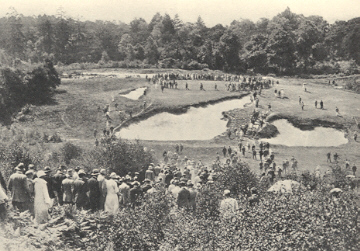
The eighth at St. George’s Hill.
Of the three heathland greats, Colt was by far the most productive writer. He was involved in no less than five books on the subject, and wrote numerous magazine articles dedicated to golf design. Many of those articles graced the pages of Country Life, but surprisingly not all were focused on golf design. In 1910 Colt wrote an article on club-house architecture. In the article he describes the qualities desired in the model club-house and provides Knebworth, West Surrey, Alwoodley, Woking, Princes and New Zealand as examples — ‘the excellent house for the Alwoodley Golf Club . . . it is of a homey character, without ornate details . . . all that can be desired, a special room for chauffeurs, with a good fireplace . . . In working a club it is always difficult to hide the empty bottles, mineral-water cases and other ’empties’ that have to be returned to their owners, and steward will certainly be glad to se the large covered shed provided for this purpose.’ One wonders if Dr.MacKenzie, an Alwoodley member, might have created a need for such a contraption. The article went on to promote simple structures exhibiting vernacular tastes, and specifically the designs of Arts and Crafts architects Edwin Lutyens, Thomas Collcutt, Stanley Hamp and Herbert Norman. ‘Occasionally, there is an opportunity of using an old farmhouse for the headquarters of the club. The illustration of the club-house of the New Zealand Golf Club gives good idea of what can be advantageously done in this respect. The interior arrangement is good, and the exterior is certainly pleasing to the eye and simple in treatment.’
But it is in Colt’s golf-architectural writing that his Arts and Crafts influences, and the influences of Hutchinson, are clearly evident. Like Park and Fowler, he admired the ancient precedents — the naturally evolved links. As Darwin described,’ Colt was a great lover of all that was old in golf. His architectural views were largely founded, I think, as have been those of his contemporaries and successors, on the Old Course at St. Andrews and its great holes.’ Each of heathland trio clearly understood the importance of nature, but Colt’s appreciation seems to be very deep. Some examples of his early views:
It will be generally agreed that the intense importance should be attached to utilising every feature of the ground . . . to depend to the maximum extent upon nature and to minimum upon art, makes for interesting golf and moderate expenditure.
Players are beginning to see how it is to place bunkers at correct distances, but few perhaps realise how difficult it is to arrange for the natural features to provide to the fullest possible extent the necessary excitement for the course, and to supplement these features without destroying the natural beauty of the site.
As regards to construction of artificial hollows, mounds, and bunkers, the model should be the natural sand-dune country which is found near the sea. If the sand-dunes be taken as the natural and perfect model, it follows that their characteristics should be reproduced. Sand bunkers should be therefore be cut in irregular shapes, and should be places in the face of natural hillocks if they exist in the desired position.
If no banks or hillocks are provided by nature they should be constructed artificially . . . to make them irregular in outline. Their skyline should be broken and rolling, and hard, straight lines should be avoided. But this side of construction more than any other demands in the construction a natural talent which is very rare, and the majority of courses therefore fall shot of the ideal standards of nature.
The old custom of squaring off the course and greens in rectangular fashion is departing, and instead we find an irregular course, with a bay of turf here and there and a promontory of heather to slightly turn the line of play to right or left as the case may be, and the result is desirable in every way. And if the heather be never leveled off, but allowed to encroach a little even on the margins, it will appear as if it were naturally growing into the turf, and the artificiality be further reduced. Everyone knows how pretty a border of flowers looks when the plants are allowed to grow over the edge and on to the paths, and the gardener’s trimming instincts are checked with a firm hand. The same thing applies to heather golf courses.
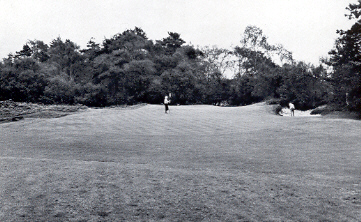
The fairway, green and hazards are well integrated at Blackmoor.
What we want to have is variety, gained by utilizing all the best natural features of the land, and alternating the holes of various lengths.
The shape and nature of bunkers can be varies with immense advantage. How often do we see a delightful landscape spoilt by the creation of a number of symmetrical pots, or banks, or humps, made apparently at so much a dozen! And this landscape might have been improved and made still pleasing to the eye by planting judiciously off the course irregular clumps of whins, or broom, or rough grasses, or possibly small birch trees and Scotch firs.
I firmly believe that the only means whereby and an attractive piece of ground can be turned into a satisfying golf course is to work the natural features of the site in question. Develop them if necessary, but not too much; and if there are many nice features, leave them alone as far as possible, but utilise them to the their fullest extent, and eventually there will be a chance of obtaining a course with individual character of an impressive nature.
Again a reflection of the Arts and Crafts ideals of simplicity, variety, harmony of man-made and environment, reverence for the past and the inherent virtue of nature — the very same ideals promoted by Hutchinson. Colt, Park and Fowler understood these ideals, and they shared another common characteristic with their Arts and Crafts brethren within the related arts — individualism. They may have shared common influences, but they also had very different experiences, tastes and backgrounds, and the result was work that reflected common ideals, but was stylistically individualistic and unique — achieving Hutchinson’s variety.
Part V
The Converging Arts in America
The phenomenon was not exclusive to Britain, there was a fusion of the new artistic movement and golf design in America. Following the British model of being an approach rather than an identified style, the American Arts and Crafts movement reflected its varied regional traditions. And there were a number of locations where the movement thrived – Boston, New York, Philadelphia, Chicago and California – the very same places that progressive golf architecture flourished.
Boston was the first, Harvard art professor Charles Eliot Norton, a friend of John Ruskin, formed the Boston Society of Arts and Crafts. And ironically the Boston area is where interesting golf-architecture first emerged in this country, rugged and rustic designs, such as Myopia Hunt, Essex County, The Country Club and Ekwanok, reflecting the qualities of their environment. Throughout New England new summer colonies developed in the mountains and along the coast, the common denominator being an appreciation for the Shingle Style of architecture and excellent golf. The Shingle Style was an American fusion of Old English and the native Colonial style, wooden structures with a skin of shingles which became the region’s universal resort style. Charles Follen McKim, Stanford White (CB Macdonald’s good friend), HH Richardson and Bruce Price were among the most prominent proponents of this style which stretched from Bar Harbor to the Hamptons, and examples include the Shinnecock Hills clubhouse and Donald Ross’s Rhode Island cottage Quaker Hills Farm. A combination of native golf architects and imported talents brought excellent golf courses to many of these summer colonies, men like Ross, Herbert Leeds, Walter Travis, Devereux Emmet, JD Dunn, Willie Park-Jr., CB Macdonald and his protégé Seth Raynor.
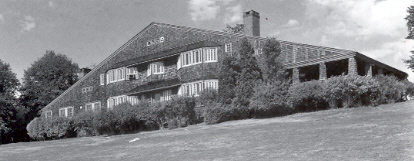
Shingle style–McKim, Mead and White, Low house, Bristol, RI (1887).
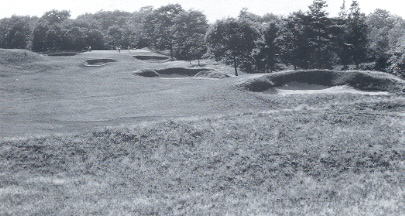
The rugged Northeast style–the 13th at Ross’s Salem CC.
In New Jersey and Upstate New York, Gustav Stickley and Elbert Hubbard created two separate Arts and Crafts cooperative communities — Craftsman Farms and Roycroft. Both men had traveled to Britain where they were introduced to the English Arts and Crafts movement, Stickley had met both Charles Ashbee and CFA Voysey in 1898, while around that same time Hubbard had met Ashbee and William Morris — both men became admitted disciples of Morris. From their workshops they produced simple furnishings which were an extreme departure from the overly decorated Victorian styles which had been popular with the upper and middle classes.With architectural tastes evolving, their plain, solid oak, rustic furniture became extremely popular throughout the nation, and were assisted no doubt by Stickley’s new magazine the The Craftsman, which promoted his simple furniture as well as the numerous Arts and Crafts architectural styles. The Craftsman had a profound effect on the American psyche, and on the success of the Arts and Crafts ideal in this country.

William Price, Stephens house, Rose Valley, Pa (1905).
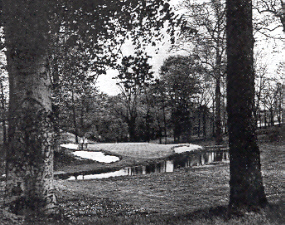
The Philadelphia style–the par-3 11th at Fynn’s Spring Mill.
Another center of Arts and Craft activity was Philadelphia. The Quaker city had a long tradition of artistic and architectural originality, epitomized by Frank Furness’s uniquely American expressions of the late 19th century. Furness’s followers — William Price, Wilson Eyre, Arthur Meigs, Arthur Mellor and Frank Miles Day — inspired by the British A&C movement formed the T-Square Club and from that created an independent Philadelphian Arts and Crafts style. With many relocating away from the city, these men were responsible for the designs that formed the new stylish suburbs. Will Price created two utopian communities in the region, Arden and Rose Valley both in the surrounding countryside. He also designed the home Edward Bok in Merion. Bok and Cyrus Curtis were the equivalent of Hudson and Rydell in the States. Curtis was a publishing giant and Bok the editor of Ladies Home Journal, both were promoters of contemporary architecture and golf. The quality of Philadelphia architecture was only eclipsed by the quality of golf design. Local designers included the already mentioned duo of Hugh Wilson and George Crump (whose father and only brother were architects), creators of the landmark designs of Merion and Pine Valley, joined by George Thomas, AW Tillinghast, William Flynn, Alex Findlay in addition to the universally active Ross—an awesome group of talents forming the so called Philadelphia School of golf architecture.
Another hotbed of the Arts and Crafts movement was Chicago. In fact it could be argued that Chicago was where the most important American movement emerged. The Prairie School was developed in Chicago by Louis Sullivan and group of younger architects — Frank Lloyd Wright, George Elmslie, Walter Burley Griffin, William Gray Purcell, Dwight Perkins and George Washington Maher — all trained in his office. They created a distinctly regional style featuring ‘refreshingly open interiors and strong horizontal lines, the Prairie House clearly evoked the freedom and sweep of the limitless midwestern landscape.’ Ironically it was Ladies Home Journal that first exposed Wright and the Prairie style to the nation. And as Wright and his colleagues were spreading their Arts and Crafts designs throughout Chicago and the Midwest, Charles Blair Macdonald was creating a similar golf movement. It was his design for the Chicago Golf Club in 1895 that would influence the entire Chicago golf tradition. Those who followed included the Scot H.J. Whigham (Macdonald’s future son-in-law), H.J.Tweedie of Hoylake, Donald Ross, CH Alison, Seth Raynor and William Langford. The early designs of Chicago GC, Onwentsia, and Midlothian exhibited a geometric quality not unlike the Prairie School designs, and that general style continued for decades. Although Macdonald was clearly the genesis for this style, one can not discount Harry Colt’s influence at Old Elm and his assistant on the project Donald Ross, who produced a number of outstanding Chicago designs, including Beverly, Oak Park and Evanston. Oak Park was the home of Wright and many of his most famous works, it is only fitting that Ross’s course would be graced by a club-house in the Prairie style designed by William Drumond.

The Prarie style: Frank Llloyd Wright, Willits house, Highland Park, Il (1901).
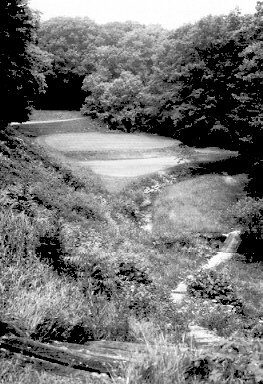
Raynor’s Short hole at Shoreacres–the Chicago style melding with nature.
Although not the first, California is where the Arts and Crafts movement was perfected. The climate was ideal, the naturally beauty was extraordinary and the numerous local traditions provided ample inspiration, including Spanish, Native American, Asian and English. In southern California the architects Irving Gill and Frank Mead created designs influenced by Native American and Spanish traditions; Charles Greene and Henry Greene created striking Japanese inspired designs of native redwood on the edge of Pasadena’s beautiful Arroyo Seco — the ‘ultimate bungalows.’ The Arts and Crafts movement was equally popular in the north and San Francisco. It started in the hills of Berkeley with Charles Keeler and Bernard Maybeck, creating simple wooden structures that seemed to have evolved naturally from the hills. The Bay Area style was made famous by Maybeck and his Berkeley colleagues John Hudson Thomas, Julia Morgan, Louis Mullgardt, among many others.

Greene & Greene, Charles Greene house, Pasadena (1906).
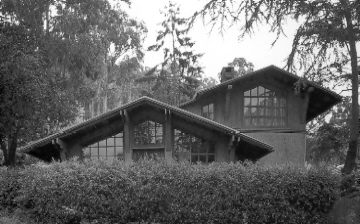
Bay Area style–Bernard Maybeck, Mathewson cottage, Berkeley (1915).
It was under this idyllic atmosphere that California golf developed, although lagging a few years behind the other arts. The first distinguished California designs arrived around 1917-1918 with Wilfred Reid’s Lakeside, AW Tillinghast’s San Francisco and Neville&Grant’s Pebble Beach, although Pebble Beach’s early expression was somewhat crude. But following WWI the Golden State produced a succession of landmark designs and redesigns created by Herbert Fowler, Norman MacBeth, Willie Watson, Max Behr, George Thomas, Robert Hunter, H.Chandler Egan and Alister MacKenzie — a period of designs possibly unmatched anywhere at anytime. And the Arts and Crafts connections were numerous. Robert Hunter lived in the Arts and Crafts colony in the Berkeley hills until the great fire of 1923, when he relocated at Pebble Beach. Hunter was instrumental in bringing MacKenzie to California, resulting in the incomparable Cypress Point and Pasatiempo. (Incidentally Hunter made his own study of Britain’s courses in 1912, inspired by his friend CB Macdonald) MacKenzie eventually made his home at Pasatiempo, a home designed by William Wurster another Arts and Crafts disciple from Berkeley. But probably the most unusual case of the arts converging involves Tasmanian born painter Francis McComas. McComas came to San Francisco in 1898, studying under Arts and Crafts architect and artist Arthur Mathews, and eventually moving to Carmel in 1912 where he became an important A&C painter in his right. He was asked to design the interior of the simple Spanish Colonial club-house at Cypress Point (George Washington Smith), which he did shortly after its completion. McComas, an avid golfer, was also responsible for designing several green complexes at Pebble Beach including the wild fourteenth, one of the most interesting greens in the world — perhaps his greatest work of art.
Each locality had their own distinct regional tradition and style, and this was reflected in the golf-architecture as well as conventional architecture. These designs reflected an appreciation for ‘fidelity of place’, one of the most important tenets of the Arts and Crafts movement. It seems apparent that many of these golf-architects were aware of this regional phenomenon, accepting it and adapting their own designs to reflect the local flavor. As an example Tillinghast’s San Francisco GC is quite different than his East coast work, but of a very similar style to other California designs, the same could be said of George Thomas. Ross’s flashy bunkering at Seminole is very much different than his more subdued bunkering in the North and East, but seems completely natural among the dunes. CH Alison’s Japanese work exhibits an Asian flair as compared to his more conventional American work found in the Midwest and East. It even seen it Britain with Colt’s inland work exhibiting an irregular and broken appearance, in contrast to his seaside designs which reflect the traditionally grass-faced look found on the ancient links. Certainly some of the differences in character can be attributed to the use of local labor, but these architects certainly didn’t fight it. In the true spirit of the A&C movement they appear to have accepted the regional traditions; adapting it to their own designs to produce superior results.
Arts and Crafts Golf
The Golden Age of golf architecture conjures up images of masters like Charles Blair Macdonald, Donald Ross and Alister MacKenzie. A wonderful image no doubt, and as a result the term ‘Golden Age’ has now become a regular part of our golfing lexicon. But one of the difficulties with the term is that it is not descriptive. Obviously it signifies a high point or a period of great achievement, but it does not describe the period’s characteristics. In fact if you reflect on the three greats mentioned above, there can hardly be three more distinctive styles. And we are now confronted by those who claim we are now enjoying a second ‘Golden Age.’ That remains to be seen, but let us hope there will eventually come a superior era — and then what, Golden Age I and Golden Age II? At that time they didn’t have a name to describe their golf design movement, and if they had I’m not certain they would have chosen ‘Golden Age’, or even ‘classical’, both being derived from the Ancient Greek and Roman civilizations which promoted symmetry and formality, the antithesis of their naturalistic expressions. I am not suggesting that the term ‘Golden Age’or ‘classical’ be rejected or erased from our golfing literature, they have served us well to this point, only that there will come a day when a more relevant term will be needed. And considering the historical circumstances and the powerful influence that this artistic movement had on all aspects of life including golf-architecture, ‘Arts and Crafts’ would not only accurately describe this golf design era, but it would allow golf-architecture to take its rightful place among the other arts.
Art is a difficult concept to grasp. It is particularly difficult to comprehend in a golf context. From our modern perspective it is not easy to visualize how an artistic or architectural movement could possibly effect golf course design. The Arts and Crafts movement, however, was more than an artistic movement, it was new way of looking at the world — actually a new old way of looking at the world. Sparked by a rejection of the modern industrial condition, it promoted artistic expression, craftsmanship, past aesthetic traditions and above all an appreciation for nature. The golf design revolution did not occur in a vacuum, it did not develop out of thin air, there was a source for its inspiration. And that source can be traced back to Horace Hutchinson. As an influential author, he was responsible for popularizing the game in England and as golf editor for Country Life, he was responsible for introducing a philosophy to the task of golf-architecture. Country Life was the one source where the Arts and Crafts movement and golf-architecture could be found side by side. Country Life provided heavy doses of the A&C ideal through its vivid images of county homes and gardens, while at the same time, under the guidance of Hutchinson, celebrating golf’s beautiful images exemplified by the ancient links. It was under these cultural and aesthetic circumstances that Willie Park sparked this revolution south and west of London at the turn of the century. And it was under these circumstances that the revolution spread first through out Britain, then to America and finally to the rest of the world.
Arts and Crafts golf, like other artistic expressions, was not a style, it was a philosophy. And in the writings of Hutchinson, and his disciples Park, Fowler and Colt, that philosophy is apparent. A philosophy that is remarkably consistent among the many of the golf-architects and theorists of this era. Their design styles may have differed and strategically they were not all in agreement — some preferring the use central hazards, some bunkers ‘en echelon’, some promoted the use of trees, and water, others did not, some were clearly strategic in nature and others leaned toward the penal. But yet the Arts and Crafts message was clear.
Golf Architecture is a new art closely allied to that of an artist or sculpture, but also necessitating a scientific knowledge of many other subjects My reputation in the past has been based on the fact that I have endeavored to conserve the existing natural features and, where these were lacking, to create formation in the spirit of nature herself. In another words, while always keeping uppermost the provision of a splendid test of golf, I have striven to achieve beauty.~~~The finest courses in existence are natural ones. Such courses as St. Andrews, and the championship courses generally, are admitted to provide a fine test of golf. It is by virtue of their natural formation that they do so. The beauty of golf courses in the past has suffered from the creations of ugly and unimaginative design. Square, flat greens and geometric bunkers have not only been an eyesore upon the whole landscape, but have detracted from the infinite variety of play which is the heritage of the game. ~~ Dr. Alister MacKenzie

Alister MacKenzie’s Lake Merced.
This chapter will not be a discourse on golfing architecture in general, even if I were qualified to write one, because its coming into being as a distinct and recognized art belongs to a period before, though not very long before, the first war. It was then that its principles were formed and began to take visible shape on many fine inland courses. At the same time those principles have enjoyed a peculiar continuity because of the distinguished artists who gradually evolved them all remained after the war. ~~~Even on the National Golf Links of America, where several great holes from Scotland and England have been carefully reproduced, there are no black sheds to catch the sliced drive at the hole which is copied from the seventeenth at St. Andrews; there is nothing but a wilderness of sand and rough. In such cases the architect is right; anything sham is surely bad art, and we do not to-day approve of the ingenious Mr.Kent, who put dead trees into some of his classical re-creations of nobleman’s gardens because they were dead trees in classical landscapes. ~~ Bernard Darwin
The point was emphasised by Ruskin many years ago that the demand for perfection was invariably a ‘sign of a misunderstanding of the ends of art.’ As for architecture (in his day such a thing as the minor art of architecture was almost unthinkable), he even went as far as to lay down the seeming paradox that ‘a work of man cannot be good unless it is imperfect.’ This application of this principle does not imply that all imperfect golf courses are necessarily admirable; but it does suggest that in the absence, fortunately, of any existing course that confounds criticism, some imperfect courses are amongst the most interesting and amusing to play.~~~The point, however, which we have to consider is that although golf architecture may be a curious and irregular form of architecture, it is architecture none the less. It has to do with building, planning, constructing in as true sense as the most ambitious works of genius with which the art is usually associated. Cathedrals, bungalows, gardens and golf courses may appear to be conflicting examples of constructive ability, yet the principles governing them follow precisely on the same lines. ~~ H.N. Wethered and Tom Simpson

Tom Simpson’s New Zealand.
To my mind, the most important thing in the Championship course is the terrain, because no matter how skillfully one may out the holes and diversifying them, nevertheless one must get thrill from nature. She must be big in mouldings for us to secure a complete exhilaration and joy of golf . . . So the truly Ideal course must have natural hazards on a large scale for superlative golf. ~~~In golf construction, art and utility meet; both are absolutely vital; one is utterly ruined without the other. On the artistic side, there is the theory of construction with the main fundamental that we copy nature; in this all seem to agree . . . The contours of our tees, of hazards, of our greens, should, except when otherwise necessary, all melt into the land surrounding them, and should appear as having always been present.~~~As noted before, diversity, and yet again, variety, is the spice of a golf course. ~~ George Thomas
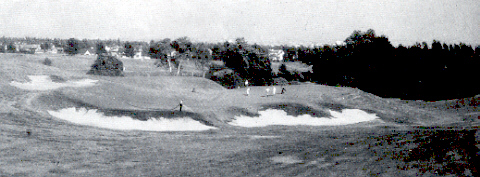
George Thomas’s 11th at Los Angeles Country Club.
Golf architecture is not an art of representation; it is, essentially, an art of interpretation. And an interpretative art allows freedom to fancy only through obedience to the law which dominates its medium, a law that lies outside ourselves. The medium of the artist is paint, and he becomes its master; but the medium of the golf architect is the surface of the earth over which the forces of Nature alone are master. ~~ Max Behr
The charm of the course lies in its diversity, the excellence of the lengths of each hole, the physical characteristics, the well-concieved system of hazards . . .and putting greens, mostly undulating.~~~The chief idea seems to have been that if the green was suitably situated and properly guarded with natural hazards, or, lacking the existence of these, the artificial creation of the same, that a good golfing holes would be had. And the aim also was to secure as much diverstiy as possible, so that no two holes would be alike, but each should present a new problem for the player.~~~Nature herself anticipated all this and has done her part nobly. It was in her kindest mood that she fashioned every dune, every gentle hollow, every foot of the entire surface and fringed it with the lapping waters of Bull’s Head Bay and Peconic Bay, wholly and solely in the interests of the true lovers of real golf. ~~ Walter Travis
Nature must always be the architect’s model. The lines of bunkers and greens must not be sharp or harsh, but easy and rolling. The development of the natural features and planning of artificial work to conform to them requires a great deal of care and forethought . . .it is good to have an eye for the beautiful. Often it is possible, by clearing away undesirable and unnecessary trees in the margin of fairways, to open up a view of some attractive picture.~~~Strive to retain as much of the natural ground formation as possible. The most beautiful courses are the ones that hew most closely to nature. ~~ Stanley Thompson
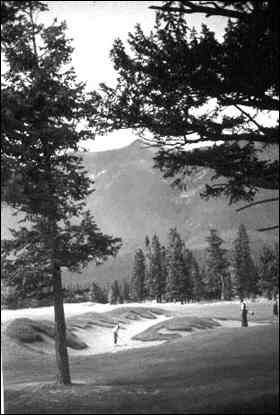
The magestic beauty of Thompson’s Banff.
The principle thought in designing a course is to produce 18 interesting holes with variety of play. A course has variety of play and character in its natural state can readily be made even in more interesting by the installation of a limited number of man-made hazards.~~~The most important consideration in conjunction with the designing of a green is to create naturalness. Of course this condition can only be brought about as construction progresses, but the frame work must be right in the beginning. Naturalness should apply on all construction on golf courses, greens, tees, mounds and bunkers alike.~~~Natural topographical features should always be developed in presenting problems in the play. As a matter of fact such features are much more desired than man made tests for they are generally more attractive. ~~ William Flynn
By natural hazards, we refer to ravines, broken faces of the land, brooks, and the like, each of which should be used to its best advantage. There is something so undeniable pleasant about a natural hazard that it seems out of the question to duplicate it artificially . . . Should you have a creek running through your property, a very interesting treatment is that of having it run across the line of play on some hole and parallel with the line of another. Don’t, however, make the creek the only hazard, as frequently done by running the holes parallel to it just for the sake of getting the creek on all possible holes. Avoid such monotony. Variety is the spice of golf, as it is of life.~~~The distinct charm of British golf lies in their environment and natural attractions. In the first particular, they possess something we cannot hope to rival: a certain sense of fitness, which is harmonizes with the ancient Scottish game. From the latter, however, we can certainly learn much by taking our course less artificial, for the fascination of the most famous hazards in the world lies in the fact they were not and could not have been constructed. ~~ Donald Ross
It is my theory that nature must precede the architect, in the laying out of links. It is futile to attempt the transformation of wholly inadequate acres into an inadequate acres into an adequate course. Invariably the result is the inauguration of an earthquake. The site of a golf course should be there, not brought there~~~Many an acre of magnificent land has been utterly destroyed by the steam shovel, throwing up its billows of earth, biting out traps and bunkers, transposing landmarks that contemporaries of Genesis. ~~ Perry Maxwell
In most cases too little is yet given to the beauty, harmony, and grandeur of the finished product. When we build golf courses we are remodeling the face of nature, and it should be remembered that ‘the greatest and fairest things are done by nature and less by art’, as Plato truly said. What garden of the world equals some of the pictures nature paints? What modern golf course equals in beauty the seaside courses, and especially those which have been left from the touch of the architect? If there has been improvement in the art of constructing golf courses, it has been largely due to the willingness of the best architects to imitate humbly and lovingly what nature has placed before them . . . And when the finished product appears it so blends itself with the surrounding landscape that few can tell where nature ends and art begins. ~~ Robert Hunter
Ask whether every green is so placed as to take the fullest possible advantage of every natural feature which the land affords; whether anything has been done artificially to increase the interest of approach play by means of slope or hollows at any hole which is dull by nature; whether every bunker is placed and constructed in such a manner as to give maximum excitement and the minimum pain to golfers of high handicap.~~~From the landscape point of view he will ask whether every artificial feature blends with its surroundings, whether every bunker creates maximum of impression on, and gives maximum thrill to, the mind of the golfer who is seeking to avoid it; Whether the aspect of all the constructional work increases the pleasure and stimulates the interest of the golfer who views it. ~~ C.H. Alison
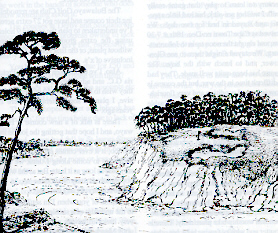
Hugh Alison’s Japanese masterpiece – Hirono.
Architecture is one of the five fine arts. If the critic’s contention is true, then architecture must be a ‘fetish’, as the basis of it is the copying of Greek and Roman architecture, Romanesque and Gothic, and our own times among other forms, Georgian and Colonial architecture. One must have the gift of imagination to successfully apply the original to new situations. Surely there is nothing ‘fetish’ about this. I believe that in reverencing anything in the life of man which has the testimony of the ages as being excelled, whether it be literature, painting, poetry, tombs—even a golf hole.~~~There should be every variety of hazard. Variety is not only ‘the spice of life’ but it is the very foundation of golfing architecture. Diversity in nature is universal. Let your golfing architecture mirror it. ~~ Charles Blair Macdonald
The difference between the golf courses of America and of Great Britain can be best expressed by two words ‘artificial’ and ‘natural’ ~~~All natural beauty should be preserved, natural hazards utilized, and a minmum of artificiality introduced. ~~ Bobby Jones
The creator of golf holes must not only possess imagination but a keen appreciation of the offering of nature, and the art of landscaping must be allied closely with that of architects.~~~Some years ago, in a city far from here, there was a famous old club. The clubhouse represented the growth years. It was a low rambling structure and from time to time, as was necessary, additions were made until the whole was Topsy-like than the original. Yet the place had lost none of its individuality. Roses rambled along the wall and riotously clambered over the doorways and roofs. Within there was an indescribable charm. It was cozy, comfortable and dignified. Finally, the lovely old place was destroyed by fire, and soon after a massive building was erected on the site. It was planned along the most modern lines and nothing that might go to make the comfort of man complete was omitted, so far as the architect, builder and decorator were concerned. But the old atmosphere was gone. From without, the stone structure suggested to many the walls of a prison or hospital. Within, it was cold in its appearance, vault like, uncomfortable. Without, there were lacking the roses and honeysuckle, the bees and the humming birds. Within, the hearty salutations and chatter of men, who were thoroughly at ease, were absent. ~~ A.W. Tillinghast
Although Tillinghast’s final quote doesn’t even touch the subject of golf-architecture in many ways it is the most illustrative, it speaks to a state of mind that lies at the heart of the Arts and Crafts ideal. After reading all these reflections, one is struck by the consistency of the message, and how it differs from many of today’s most successful practitioners. That unanimity of thought is even more remarkable when considering the message is coming from such an extraordinarily diverse group: physician, artist, sociologist, farmer, solicitor, historian, journalists, horticulturist, stockbroker, socialites, banker, businessmen and carpenter. Their common characteristics were intelligence, analytical ability, artistic appreciation and a need to express themselves in writing (much like architects and craftsmen whose writings dominated the books and periodicals of the time). And though their backgrounds may have differed their message was clear: a profound appreciation for the natural and the artistic. They all shared a universal respect for the beauty and variety found in nature, they believed that not only should it be preserved and maximized, but that when intervention was needed nature must be the model. They saw themselves as artists — artists who were collaborators with Nature. As opposed to those designers who see Nature as something that needs to be conquered or overcome.
There has always been a certain romantic quality to this era, so many colorful personalities, so many wonderful courses. Many feel this romanticism has led to an over evaluation, that this period may not be all its cracked up to be. They will tell you that these men were presented with nothing but outstanding sites and they didn’t have to deal with modern environmental restrictions. That their designs benefit from decades of maturity and improvements. The reason they are called ‘classic’ is simply because they are old — there is a certain appeal to all things old and we are all effected by the history made on those fairways. And finally they claim that due to technological limitations their designs are flawed; these men would have moved dirt if they could have, and in the process eliminated those odd holes that always seem to pop up on every course.
I will grant some of these points — there is no doubt a romantic factor, maturity can be a benefit (but not always), and history may effect one’s judgment — however, even taking these potential prejudices into account, the Arts and Crafts’ golf courses still remain the greatest expression the game has ever known. Some courses have certainly improved, but a great many were as dramatic the day they were born as they are today, and in several cases more dramatic. The reason these courses are so appealing and the reason they thrive today is because their strength is fundamentally derived from Nature — it is quite simple, these men understood that the truly great golf courses must be in accord with Nature. They understood the appeal of variety and haphazard disorder, and because of that it is doubtful they would have moved earth as frequently or as eagerly as many of our modern men, and the truth is they had the ability. They knew the occasional odd feature or odd hole reflected Nature’s unpredictability, and added interest to an organic experience. If anything the lesson learned is that modern technology should be used judiciously. Take our inner cities as an example, technology and Modern architecture has given us high-rise low-cost mass housing to replace the neighborhoods of old Brownstones. There was belief that these sparkling modern structures would improve the quality of life, but it resulted in a cold empty de-humanizing existence and the loss of individuality, and these neighborhoods have deteriorated. Might there be some parallels between modern architecture and golf design? A lack of respect for the old work illustrated by too frequent ‘modernization’; a reliance on machinery at the expense of the individual craftsmanship. Modern tools have given golf designers unprecedented capabilities, but should it be at the expense of individuality? Is it a coincidence that many of our most appealing modern designs are those where the individual craftsmen’s importance has been stressed?
I wrote this piece for two reasons. First, I needed to satisfy my own curiosity. Why did this era begin, what circumstances brought about this revolution? What did these men of such diverse professional backgrounds and design styles have in common, if they had anything in common? The second reason was to compare and contrast the past with the present–not only from stylistic standpoint, but also from a philosophical standpoint. Many modern designers express an admiration for the ‘Golden Age’ — suggesting they are emulating this era’s finest features. Perhaps incorporating MacKenzie or Thomas bunkering, or borrowing the Macdonald/Raynor look, or some other ‘classic’ feature and wrapping it all in waves of fescue. However many times these ‘tributes’ are often disappointing, the features and the look might be there, but there is something just not right. Arts and Crafts golf was more than a collection of superficial features or any particular style, it was an approach — ‘its fascination as a movement lies in its extension beyond the physical limits of design.’ These men each had their own distinctive style, however they shared a foundation of the Arts and Crafts approach, and those today who wish to pay tribute might consider looking ‘beyond the physical limits of design.’ I understand the Arts and Crafts era can not be re-created, the reality is that we live in a more complicated world. But their common approach needs to be explored, I do not believe it is idealistic or unrealistic, the effort would be worthwhile considering the product of that sensibility is still the most beautiful the game has produced. My hope is that modern golf-architecture will benefit from the eloquence of the Arts and Crafts argument.
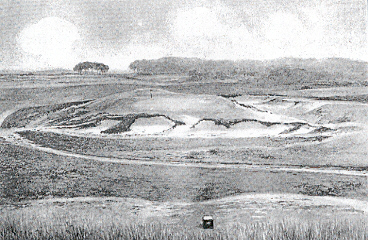
Colt’s fifth at Sunningdale New.
The End







